100个最常见的英语词根词缀
单词前缀后缀词根总表
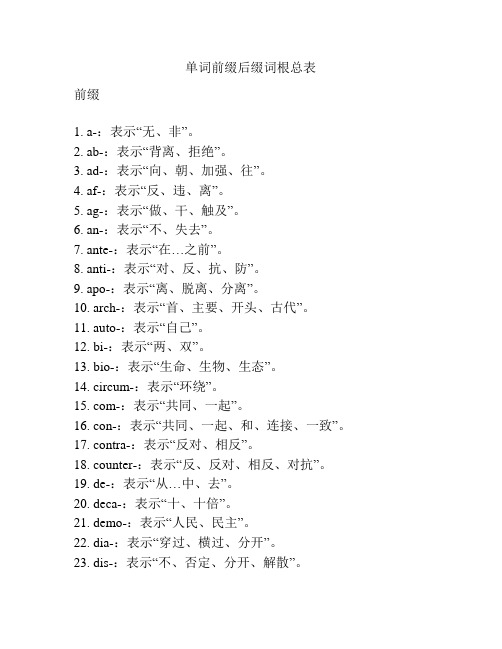
单词前缀后缀词根总表前缀1. a-:表示“无、非”。
2. ab-:表示“背离、拒绝”。
3. ad-:表示“向、朝、加强、往”。
4. af-:表示“反、违、离”。
5. ag-:表示“做、干、触及”。
6. an-:表示“不、失去”。
7. ante-:表示“在…之前”。
8. anti-:表示“对、反、抗、防”。
9. apo-:表示“离、脱离、分离”。
10. arch-:表示“首、主要、开头、古代”。
11. auto-:表示“自己”。
12. bi-:表示“两、双”。
13. bio-:表示“生命、生物、生态”。
14. circum-:表示“环绕”。
15. com-:表示“共同、一起”。
16. con-:表示“共同、一起、和、连接、一致”。
17. contra-:表示“反对、相反”。
18. counter-:表示“反、反对、相反、对抗”。
19. de-:表示“从…中、去”。
20. deca-:表示“十、十倍”。
21. demo-:表示“人民、民主”。
22. dia-:表示“穿过、横过、分开”。
23. dis-:表示“不、否定、分开、解散”。
24. dys-:表示“困难、不良、不正常、疾病”。
25. e-:表示“外、向外、遮盖”。
26. eco-:表示“环境、生态”。
27. electro-:表示“电、电气”。
28. endo-:表示“内、内部、从内部”。
29. ento-:表示“内部、内、里”。
30. epi-:表示“上、在…之上、附着于…”。
31. eu-:表示“美好、好、正常、真实、合适”。
32. ex-:表示“出、向外、向…之外,除去”。
33. extra-:表示“额外的、在…之外的”。
34. fore-:表示“先、前、预先、早”。
35. geo-:表示“地球、大地、地理、地球学”。
36. hepta-:表示“七、七个”。
37. hexa-:表示“六、六个”。
38. homo-:表示“同样的、相同的、一致的”。
英语单词最常用词根

英语单词最常用词根一、“ag”,[æɡ],表示“做,动”(verb,v.)1. agent:[ˈeɪdʒənt],n. 代理人;代理商。
- 例如:A travel agent helps people plan their trips.(旅行代理商帮助人们规划旅行。
)2. agitate:[ˈædʒɪteɪt],v. 鼓动;搅动;使焦虑。
- 例如:The wind agitated the leaves.(风搅动树叶。
)二、“ann”,[æn],表示“年”(noun,n.)1. annual:[ˈænjuəl],adj. 每年的;年度的;n. 年刊;一年生植物。
- 例如:The company holds an annual meeting.(公司举行年度会议。
)- We planted some annuals in the garden.(我们在花园里种了一些一年生植物。
)2. anniversary:[ˌænɪˈvɜːsəri],n. 周年纪念日。
- 例如:Today is their wedding anniversary.(今天是他们的结婚周年纪念日。
)三、“audi”,[ɔːdi],表示“听”(verb或noun,v. / n.)1. audience:[ˈɔːdiəns],n. 观众;听众。
- 例如:The audience enjoyed the concert very much.(观众非常喜欢这场音乐会。
)2. audio:[ˈɔːdiəʊ],adj. 音频的;声音的;n. 音频。
- 例如:This device can play audio files.(这个设备能播放音频文件。
)四、“bene”,[beni],表示“善,好”(adjective或noun,adj. / n.)1. benefit:[ˈbenɪfɪt],n. 利益;好处;v. 有益于;受益。
英语前缀后缀词根总表

英语前缀后缀词根总表前缀是指加在词根前面的一个字母或几个字母,用来改变词的意思或形成新词。
后缀是指加在词根后面的一个字母或几个字母,也用于改变词的意思或形成新词。
词根是一个单词的核心部分,没有前缀和后缀的部分。
下面是英语常见的前缀、后缀和词根总表,以供参考:一、常见前缀1. a-, an-:无、非(例如:apathy 无感情、amoral 不道德)2. anti-:反对、抗(例如:antisocial 反社会、antibiotic 抗生素)3. auto-:自动、自发(例如:autopilot 自动驾驶、autonomous 自主的)4. bi-:两个、双重(例如:bilingual 双语的、biweekly 每两周一次)5. circum-:围绕(例如:circumference 圆周、circumnavigate 环球航行)6. co-, com-, con-:共同、一起(例如:coexist 共存、commitment承诺、conquer 征服)7. de-:否定、向下(例如:decipher 破译、degrade 降低)8. dis-:不、非(例如:disappear 消失、disapprove 不赞同)9. en-, em-,in-, im-:使、进入、加强(例如:encourage 鼓励、empower 授权、inject 注射、improve 改善)10. ex-:出、向外(例如:exit 出口、expand 扩大)11. fore-:在前面、预先(例如:foresee 预见、forefather 先祖)12. hyper-:超过、过度(例如:hypersensitive 过敏的、hyperactive过动的)13. inter-:相互、在中间(例如:interact 互动、intermediate 中间的)14. mis-:错误、坏(例如:misunderstand 误解、misbehave 行为不端)15. multi-:多(例如:multinational 跨国的、multicultural 多元文化的)16. neo-:新、重新(例如:neonatal 新生儿的、neoclassical 新古典主义的)17. non-:不、非(例如:nonstop 不停的、nonsense 无意义的)18. over-:过度、超过(例如:overcome 克服、overreact 反应过激)19. post-:后、之后(例如:postpone 推迟、postgraduate 研究生)20. pre-:前、之前(例如:preheat 预热、preview 预览)21. re-:重新(例如:rebuild 重建、rethink 重新考虑)22. sub-:在下面、次级(例如:subway 地铁、subordinate 次要的)23. trans-:穿过、转移(例如:transportation 运输、transmit 传输)24. un-:不(例如:unhappy 不开心、unfair 不公平)二、常见后缀1. -able, -ible:能够(例如:comfortable 舒适的、legible 清晰可读的)2. -al, -ial:有关、属于(例如:global 全球的、commercial 商业的)3. -ed, -ing:过去式、现在分词(例如:played 玩过、singing 唱歌)4. -er, -or:某人(例如:teacher 教师、actor 演员)5. -ful:充满、有(例如:helpful 有帮助的、beautiful 美丽的)6. -ic, -ical:相关的、特定的(例如:scientific 科学的、historical 历史的)7. -ion, -tion, -sion:名词后缀(例如:action 行动、attention 注意、decision 决定)8. -ish:类似、相似(例如:childish 孩子气的、selfish 自私的)9. -ist:从事某事的人(例如:artist 艺术家、scientist 科学家)10. -ive:具有某种特性或倾向(例如:creative 有创造力的、active积极的)11. -less:没有、缺乏(例如:hopeless 绝望的、useless 无用的)12. -ly:副词后缀(例如:quickly 快速地、happily 快乐地)13. -ment:名词后缀(例如:improvement 改进、development 发展)14. -ness:名词后缀,表示状态或性质(例如:kindness 友善、happiness 幸福)15. -ous:多、充满(例如:famous 著名的、dangerous 危险的)三、常见词根1. act:行动(例如:act 行动、react 反应)2. aud, audio:听觉、声音(例如:audience 观众、audiovisual 视听的)3. bio:生命(例如:biology 生物学、biography 传记)4. chron:时间(例如:chronological 按时间顺序的、chronic 慢性的)5. dict:说(例如:dictionary 字典、predict 预言)6. graph, graphy:写、画(例如:autograph 亲笔签名、photography摄影)7. log, logo:言论、话语(例如:dialogue 对话、logic 逻辑)8. manu:手(例如:manufacture 制造、manual 手册)9. path:感情、痛苦(例如:empathy 同情心、pathetic 可怜的)10. port:运输(例如:transport 运输、porter 搬运工)11. sci:知识(例如:science 科学、conscious 有意识的)12. struct:建设、构建(例如:structure 结构、instruct 教导)以上是英语常见的前缀、后缀和词根总表,希望对你的学习有所帮助。
英语常用252个词根
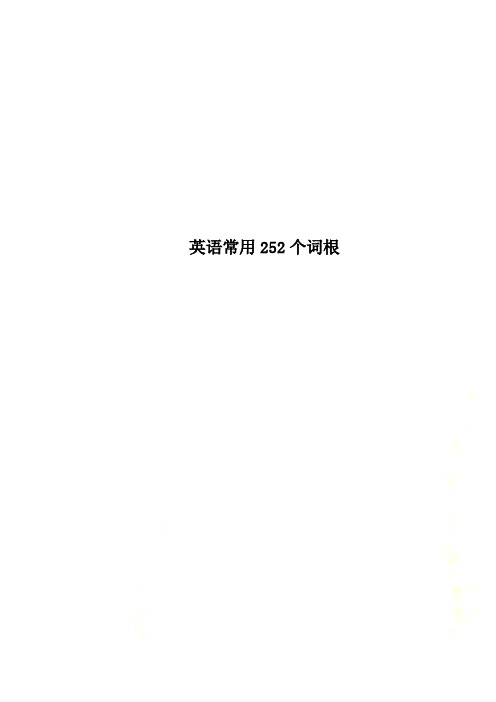
英语常用252个词根英语中最常用的252个词根英语常见252个字根1,ag=do,act 做,动2,agri=field 田地,农田(agri也做agro,agr)3,ann=year年4,audi=hear听5,bell=war战争6,brev=short短7,ced,ceed,cess=go行走8,cept=take拿取9,cid,cis=cut,kill切,杀10,circ=ring环,圈11,claim,clam=cry,shout喊叫12,clar=clear清楚,明白13,clud=close,shut关闭14,cogn=known知道15,cord=heart心16,corpor=body体17,cred=believe,trust相信,信任18,cruc=cross 十字19,cur=care关心20,cur,curs,cour,cours=run跑21,dent=tooth牙齿22,di=day 日23,dict=say说24,dit=give给25,don=give给26,du=tow二27,duc,duct=lead引导28,ed=eat吃29,equ=equal等,均,平30,ev=age年龄,寿命,时代,时期31,fact=do,make做,作32,fer=bring,carry带拿33,flor=flower花34,flu=flow流35,fus=pour灌,流,倾泄36,grad=step,go,grade步,走,级37,gram=write,draw写,画,文字,图形38,graph=write,records写,画,记录器,图形39,gress=go,walk 行走40,habit=dwell居住41,hibit=hold拿,持42,hospit=guest客人43,idio=peculiar,own,private,proper特殊的,个人的,专有的44,insul=island岛45,it=go行走46,ject=throw投掷47,juven=young年轻,年少48,lectchoose,gather选,收49,lev=raise举,升50,liber=free自由51,lingu=language语言52,liter=letter文字,字母53,loc=place地方54,log=speak言,说55,loqu=speak言,说56,lun=moon月亮57,man=dwell,stay居住,停留58,manu=hand手59,mar=sea海60,medi=middle中间61,memor=memory记忆62,merg=dip,sink 沉,没63,migr=remove,move迁移64,milit=soldier兵65,mini=small,little小66,mir=wonder惊奇67,miss=send 投,送,发(miss也作mit)68,mob=move动69,mort=death死70,mot=move移动,动71,nomin=name名72,nov=new新73,numer=number 数74,onym=name 名75,oper=work工作76,ori=rise升起77,paci=peace和平,平静78,pel=push,drive推,逐,驱79,pend,pens=hang悬挂/weigh称量/pay支出,付钱,花费80,pet=seek追求81,phon=sound声音82,pict=paint画,描绘83,plen=full满,全84,plic=fold折,重叠85,pon=put放置86,popul=people人民87,port=carry拿,带,运88,pos=put放置89,preci=price价值90,punct=point,prick点,刺91,pur=pure清,纯,净92,rect=right,straight正,直93,rupt=break破94,sal=salt盐95,scend,scens=climb爬,攀96,sci=know知97,sec,sequ=follow跟随98,sect=cut切割99,sent,sens=feel感觉100,sid=sit坐101,sist=stand站立102,son=sound声音103,spect=look看104,spir=breathe呼吸105,tail=cut切割106,tain,ten,tin=hold握,持,守107,tect=cover掩盖108,tele=far远109,tempor=time时110,tend(tens,tent)=stretch伸111,terr=land,earth土地,陆地112,text=weave纺织113,tract=draw拉,抽,引114,un=one一115,urb=city城市116,vac,vacu=empty空117,vad,vas=walk,go行走118,vari=change变化119,ven=come来120,vert,vers=turn转121,vi,via=way道路122,vis,vid=see看123,vit=life生命124,viv=live活第二部分,多认词根,多识单词。
常用词根词缀表配单词

常用词根词缀表配单词一、常用前缀。
1. un - [ʌn](否定前缀,形容词、副词前缀)- unhappy [ʌnˈhæpi] adj. 不快乐的。
- unlock [ʌnˈlɒk] v. 开锁(un - + lock锁,v.)2. re - [riː](表示“再,又;回”,动词前缀)- rewrite [ˌriːˈraɪt] v. 重写(re - + write写,v.)- return [rɪˈtɜːn] v. 返回(re - + turn转,v.)3. in -(im - 在b, m, p前) [ɪn](否定前缀,形容词、名词前缀)- incorrect [ˌɪnkəˈrekt] adj. 不正确的。
- impossible [ɪmˈpɒsəbl] adj. 不可能的(im - + possible可能的,adj.)4. dis - [dɪs](否定前缀,动词、形容词、名词前缀)- dislike [dɪsˈlaɪk] v. 不喜欢(dis - + like喜欢,v.)- disorder [dɪsˈɔːdə(r)] n. 混乱(dis - + order秩序,n.)二、常用后缀。
1. - er(表示人或物) [ə(r)](名词后缀)- teacher [ˈtiːtʃə(r)] n. 教师(teach教,v. + - er)- cooker [ˈkʊkə(r)] n. 炊具(cook煮,v. + - er)2. - able(表示“可…的,能…的”) [əbl](形容词后缀)- comfortable [ˈkʌmftəbl] adj. 舒适的(comfort安慰,n. + - able)- acceptable [əkˈseptəbl] adj. 可接受的(accept接受,v. + - able)3. - ful(表示“充满…的”) [fʊl](形容词后缀)- beautiful [ˈbjuːtɪfl] adj. 美丽的(beauty美,n. + - ful)- helpful [ˈhelpfl] adj. 有帮助的(help帮助,v. + - ful)三、常用词根。
100个常用词根词缀
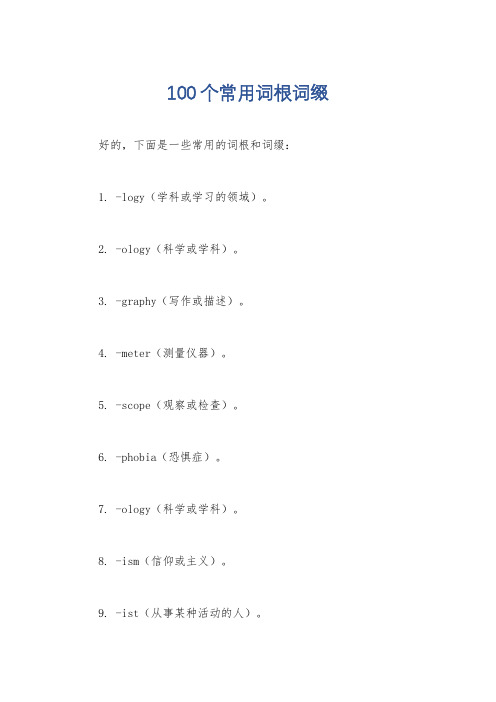
100个常用词根词缀好的,下面是一些常用的词根和词缀:1. -logy(学科或学习的领域)。
2. -ology(科学或学科)。
3. -graphy(写作或描述)。
4. -meter(测量仪器)。
5. -scope(观察或检查)。
6. -phobia(恐惧症)。
7. -ology(科学或学科)。
8. -ism(信仰或主义)。
9. -ist(从事某种活动的人)。
10. -ology(科学或学科)。
11. -able(能够做某事的)。
12. -ful(充满的)。
13. -less(没有的)。
14. -ment(行为或结果)。
15. -ology(科学或学科)。
16. -phobia(恐惧症)。
17. -ology(科学或学科)。
18. -graphy(写作或描述)。
19. -meter(测量仪器)。
20. -scope(观察或检查)。
21. -phobia(恐惧症)。
22. -ology(科学或学科)。
23. -ism(信仰或主义)。
24. -ist(从事某种活动的人)。
25. -ology(科学或学科)。
26. -able(能够做某事的)。
27. -ful(充满的)。
28. -less(没有的)。
29. -ment(行为或结果)。
30. -ology(科学或学科)。
31. -phobia(恐惧症)。
32. -ology(科学或学科)。
33. -graphy(写作或描述)。
34. -meter(测量仪器)。
35. -scope(观察或检查)。
36. -phobia(恐惧症)。
37. -ology(科学或学科)。
38. -ism(信仰或主义)。
39. -ist(从事某种活动的人)。
40. -ology(科学或学科)。
41. -able(能够做某事的)。
42. -ful(充满的)。
43. -less(没有的)。
44. -ment(行为或结果)。
45. -ology(科学或学科)。
46. -phobia(恐惧症)。
(完整版)英语词根词缀表(最全)
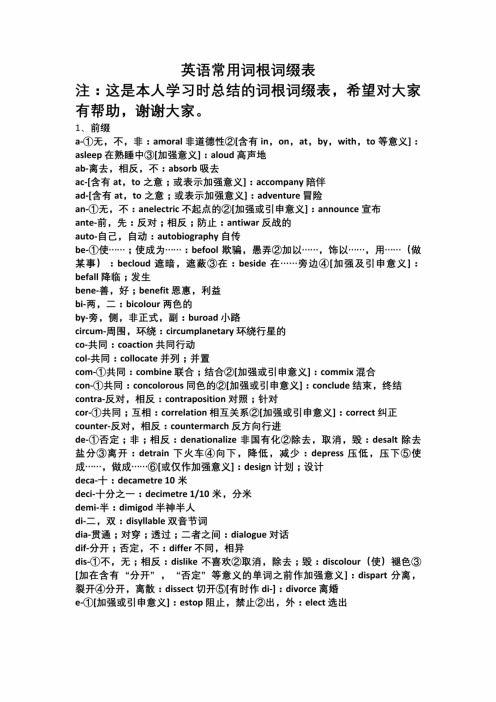
-demi 半 :dimigod 半神半人
-di 二,双 :disyllable 双音节词
-dia 贯通 ;对穿 ;透过 ;二者之间 :dialogue 对话 -dif 分开 ;否定,不 :differ 不同,相异 --dis ①不,无 ;相反 :dislike 不喜欢②取消,除去 ;毁 :discolour (使) 摧色③ - [加在含有 "分开” , "否定” 等意义的单词之前作加强意义]: dispart 分离,
-hepta [在元音前作 hept 】七 :heptagon 七角形
- - - il [用在 ■ 之前]①不 ;无 ;非 :illogical 不合逻辑的②[加强或引申意义]:
illustrate 说明,表明
im [用在 b, m, p 之前]①不 ;无 ;非 :impossible 不可能的②内向,入 :import
英语常用词根词缀表
注 :这是本人学习时总结的词根词缀表,希望对大家
有帮助,谢谢大家。
-1、前缀
a ①无,不,非 :amoral 非道德性②[含有 in, on, at, by, with, to 等意义]:
asle印在熟睡中③[加强意义]:aloud 高声地
ab 离去,相反,不 :absorb 吸去
- tele ①远:telescope 望远镜②电视:teletext 利用电脑提供的电视信息服务
- trans ① 越过,横过;超:transnational 超越国界的 ② 转移,变换 :
translate 翻译/transplant 移植
-tri H:triangle 三角形/tricar 三轮车 -twi 二,两:twifold 两部,双重/twiforked 两叉状的 -un ®不:unhappy 不快乐的②无:unmanned 无人驾驶的③非:unjust 非正义
100个最常见的英语词根词缀

主题: 英语构词法一些常用的词缀和词根掌握一些英语构词法,对单词的记忆和理解有很大的帮助,下面笔者列举一些常用的词缀和词根。
一. 常见的前缀1.表示否定意义的前缀1)纯否定前缀a-, an-, asymmetry(不对称)anhydrous(无水的)dis- dishonest, dislikein-, ig-, il, im, ir, incapable, inability, ignoble, impossible, immoral, illegal, irregularne-, n-, none, neither, nevernon-, noesenseneg-, neglectun- unable, unemployment2)表示错误的意义male-, mal-, malfunction, maladjustment(失调)mis-, mistake, misleadpseudo-, pseudonym(假名), pseudoscience3)表示反动作的意思de-, defend, demodulation(解调)dis-, disarm, disconnectun-, unload, uncover4)表示相反,相互对立意思anti-, ant- antiknock( 防震), antiforeign,(排外的)contra-, contre-, contro-, contradiction, controflow(逆流)counter-, counterreaction, counterbalanceob-, oc-, of-, op-, object, oppose, occupywith-, withdraw, withstand2. 表示空间位置,方向关系的前缀1)a- 表示“在……之上”,“向……”aboard, aside,2)by- 表示“附近,邻近,边侧”bypath, bypass(弯路)3)circum-, circu-, 表示“周围,环绕,回转”circumstance, circuit4)de-, 表示“在下,向下”descend, degrade5)en-, 表示“在内,进入”encage, enbed(上床)6)ex-, ec-, es-, 表示“外部,外”exit, eclipse, expand, export7)extra-, 表示“额外”extraction (提取)8)fore- 表示“在前面”forehead, foreground9)in-, il-, im-, ir-, 表示“向内,在内,背于”inland, invade, inside, import10)inter-, intel-, 表示“在……间,相互”international, interaction, internet11)intro-, 表示“向内,在内,内侧”introduce, introduce12)medi-, med-, mid-, 表示“中,中间”Mediterranean, midposition13)out-, 表示“在上面,在外部,在外”outline, outside, outward14)over-, 表示“在上面,在外部,向上”overlook, overhead, overboard15)post-, 表示"向后,在后边,次”postscript(附言),16)pre-, 表示"在前”在前面”prefix, preface, preposition17)pro-, 表示“在前,向前”progress, proceed,18)sub-, suc-, suf-, sug-, sum-, sup-, sur-, sus-, 表示“在下面,下”subway, submarine, suffix, suppress, supplement19)super-, sur-, 表示“在…..之上”superficial, surface, superstructure20)trans-, 表示“移上,转上,在那一边”translate, transform, transoceanic21)under-, 表示“在…..下面,下的”underline, underground, underwater22)up-, 表示“向上,向上面,在上”upward, uphold, uphill(上坡)3. 表示时间,序列关系的前缀1)ante-, anti-, 表示“先前,早于,预先”antecedent, anticipate,2)ex-, 表示“先,故,旧”expresident, exhu我的好友and3)fore-, 表示“在前面,先前,前面”foreward, dorecast, foretell(预言)4)mid-, medi-, 表示“中,中间”midnight, midsummer5)post-"表示“在后,后”postwar,6)pre-, pri-, 表示“在前,事先,预先”preheat, prewar, prehistory7)pro-, 表示“在前,先,前”prologue(序幕),prophet(预言家)8)re-, 表示“再一次,重新”retell, rewrite4. 表示比较程度差别关系的前缀1)by-, 表示“副,次要的”byproduct, bywork(副业)2)extra-,表示“超越,额外”extraordinary,3)hyper- 表示“超过,极度”hypersonic(超声波), hypertesion(高血压)4)out-,表示“超过,过分”outdo(超过), outbid(出价过高的人)5)over-,表示“超过,过度,太”overeat, overdress, oversleep6) sub-, suc-, sur-, 表示“低,次,副,亚”subeditor, subordinate, subtropical(亚热带)7)super-, sur- 表示“超过”supernature, superpower, surplus, surpass8)under-,表示“低劣,低下”undersize, undergrown, underproduction(生产不足) 9)vice- 表示“副,次”vicepresident, vicechairman5. 表示共同,相等意思的前缀1)com-, cop-, con-, cor-, co- 表示“共同,一起”。
考研英语词根词缀表

英语词根词缀记忆大全第一部分通过词缀认识单词(常用前缀一)1.①加在单词或词根前面, 表示"不, 无, 非"无中心的(中心的)不好社交的(好社交的)非道德性的(道德的;注意: 不道德的).不关政治的(政治的)反常的(正常的)②加在单词前, 表示"在…, …的"睡着的(睡觉)在边上(旁边)在前地(头)活的(活).泛滥的(冲洗)2.加在词根前, 表示"相反, 变坏, 离去"等反常的(正常的)滥用(用→用坏→滥用)吸收(吸收→吸收掉)缺席的(出现→没有出现→缺席的)诱拐(引导→引走→诱拐)可怜的(抛→抛掉→可怜的)抽象的;心不在焉的(拉→被拉开→心不在焉)戒绝(拿住→不再拿住→戒绝)潜逃(藏→藏起来→潜逃)废除(剪切→切掉→废除)切除(剪→剪掉→切除)节制;禁欲(拿住→不在拿住→戒除, 禁欲)3.等加在同辅音字母的词根前, 表示"一再"等加强意陪伴(伙伴→陪伴)加速(速度→一再增加速度)强制(唱歌→一再唱出→强调)积累(堆积→堆积起来→积累)使习惯(习俗→习惯习俗)上瘾, 入迷(说→一再说起→对……入迷)上瘾的(的形容词)引证, 举例(引导→一再引导→举例说明)亲切的(说话→不断可以说话→亲切)买得起(拿出→一再拿出{钱}→买得起)肯定(坚定→肯定)侵略, 进攻(走→一再往前走→进攻)扩大(大→一再大→扩大[权力]等)恶化(重病加重)通告(通知→通告)使震惊(白色→[脸]变白→受惊)鼓掌(赞扬→一再赞扬→鼓掌)欣赏(价值→一再给价→欣赏)指定, 任命(指→指定)安排(排列→安排)逮捕, 阻止(休息→不让动→逮捕)到达(河→到达河边→达到目标)进攻(跳→跳起来→进攻)勤奋的(坐→一再坐着[学习] →勤奋)帮助(站→站过来→帮助)联合, 结合(社团→结成团队→联合)吸收;同化(相同→成为相同→同化)肯定;确信(确定→一不再确定→肯定)附上;依恋(接角→接触上→附上)达到;获得(拿住→获得)(关心→关心到了→出度)吸引(拉→拉过来→吸引)证实(试验→一再试验→证实)4.加在在单词或词根前, 表示"做…, 加强…"适应(能力→有适应能力)熟练的(能力→有做事能力→熟练的)收养;采纳(选择→选出来→采纳)坚持(粘→粘在一起→坚持)邻近的(躺→躺在一起→邻近的)贴近;毗连(参加→参加在一起→贴近)管理;执行(部长→做部长→管理)羡慕(惊奇→惊喜;羡慕)预示(影子→[将来的]影子出现→预示)调整(正确→弄正确→调整)冒险(冒险)告诫, 警告(警告→一再警告)来临, 来到(来→来到)5、表示"两个, 两种"两栖动物(生命→两个生命→两栖动物)水陆两用车(车→两用车)6、在词根前, 表示"不, 无"无政府主义(统治→无统治→无政府主义)不和谐的(和谐的→不和谐的)无回声的(回声→无回声的)匿名的(名字→匿名的)7、表示"错误, 在旁边, 分开"类比;类似(讲话→再旁边讲→讲一样的东西→类似)类似的(的形容词)分析(分开→分开来→分析)8、表示"前面, 先"提前写日期;先于, 早于(日期→提前写日期)前面的([…的] →前面的)(走→走在前面的[事] →前事)9、表示"反对, 相反"反战的(战争)反感(感情)对立;反论(论文;观点)抗菌的(细菌的)抗体(身体)10、人, 人类(o)[人类, …学者]人类学[人类, …学者]人类学者[人类, 地理学]人类地理学[人, 形, …的]有人形的, 似人的[人类, 社会学]人类社会学11.人民―(1)[人民→居民, 名词字尾]全体居民, 人口 [人民→居民, …的]人口稠密的[人民, 动词字尾, 使…,做…]使人民居住于…中, 使人口集中在…之中, 移民于….[再, 重新, 见上]使人民重新居住于…[除去, 去掉, 人民→人口, 使…]使(某地)人口减少, 减少人口[见上, 名词字尾, 表示性质]大众性, 通俗性[见上, - …化, 使…](使)大众化, (使)普与, 推广[见上, 者]普与者, 推广者[见上, 表示行为]普与, 推广, 通俗化[人民→平民, 名词字尾]平民, 大众人民-(2)(o)[人民, 统治;"人民统治"→人民做主→]民主;民主政治, 民主政体;民主主义[见上, 主张…统治的人]民主主义者[见上, 主义]民主主义[见上, …化]民主化;使民主化[见上, …的]民主的, 民主主义的;民主政体的[人民→人数, 人口, 写, 记录→统计]人口统计学[见上, …的]人口统计的[在…之间, 人民, …的;"流行于人民之中的" →]流行的, 传染的;流行病, 时疫[见上, - 连接字母, …学]流行病学[见上, …学者]流行病学者[见上, …学的]流行病学的男-(1)(o)[男人, 女人]具有男妇两性的人, 阴阳人[男, 女, 表性质状态]半男半女男-(2)[男, 形容词字尾, …的]男的, 男性的, 男子的, 有男子气概的, 有男性生殖力的[见上, 表示现象]男性现象[见上, 表示性质]男子气概, 男生殖力, 男子的成年女-(1)(o); (o)[妇女, …学]妇科学, 妇科[见上, 人]妇科医生[妇女, …的]妇女的, 妇人的女-(2);[女, 妇女]女性的, 妇女的;女子[女, …的]女性的, 妇女的[女, 表示性质]女性, 妇女的特性[(e)女性的, 表示性质]女子的气质, 女人气, 妇女总称[女, 主义]男女平等主义;[表示行为]争取女权运动妇女;妻子12.①构成动词, 表示"使…成为"欺骗(欺骗)掩盖(说慌)遗留给, 传下(要求→要求给某人→遗留给)围攻(包围→包围起来)注意(注意)友好对待(朋友)欺骗(笨蛋→使人成笨蛋→欺骗别人)降临;发生(掉下→掉下来→发生)小看(小→小看人)使…迷惑(迷惑)②构成一些介词在前面(前面)在下面(下面)13. 表示"善, 好"好意的(意愿→好意的)好事;恩惠(做→好事)好处, 利益(做→做事后的好处→利益)祝福(说→说好话)仁慈的, 善行的(做→做好事的)14.表示"两个, 两"双周刊(星期→两星期)双语种的(语言→双语的)两年一次的(年→两年〔一次〕的)一年两次的([年]→一年两次的)15、表示"在旁边, 副的"副产品(产品)辅路(路)小道(小路)过时的(过去的)旁路;忽略(通过→从旁边通过→忽略)副业(工作)16、表示"环绕, 周围"环割(切→环切)周长(带来→→带来一圈→周长)环航世界(航行)限制(写→规定范围→限制)小心谨慎的(站→站在周围→环境)回避(走→绕圈走→回避)17、表示"共同", 通常放在元音词根前合作(操作→共同操作→合作)凝结(凝聚→凝聚起来)联合;合作(联盟)共存(存在)附着;粘着(粘→粘在一起)一致, 符合, 巧合(进掉下→共同掉进来→巧合)协调: 同等的(顺序→顺序一样→同等的引申为平等;协调)18、在同辅音词根前, 表示"共同"协作;合著(劳动→共同劳动)并置, 排列(地方→放在同一地方→排列) 用同一种语言的(语言→同语言的)倒塌(滑倒→全部滑倒→倒塌)校对(放→放到一起→校对)并列的, 并行的(边→→周边的→并列的) 同事(→捆绑→捆绑在一起的人→同事)收集(选择→放在一起选择→收集)学院的;学生的(读→共同读书→学院的) 口语的(说→两人一起说→口语会话的)共谋, 勾结(玩→共同玩弄→共谋)改正, 纠正(正→全部改正→纠正)通信;符合(反应→共同反应→相互通信)腐败的;变环的(断→全部断→变坏的, 腐败的)能够改正的(改正→全部改正的)证实(力量→用力量→证实)19、表示"共同"联合, 结合(捆→捆在一起→结合)同情(爱国者→同胞)同胞(动→大家一起动→动乱)赞扬;推荐(信任;命令→大家信任→赞扬;参考;)纪念(记住→大家一起记住→纪念)相等的, 相称的(测量→能放在一起的测量→相等的)比较(平等→一起平等→比较)紧密的;合同(压紧→全部压紧→紧密的)安慰(加强→[精神]强大→安慰)宽敞的(动→共同动→有动的地方→宽敞的) 比赛(追求→一起追→比赛)成分(放→放到一起[的东西]→成分)压缩(压→一起压→压缩) 同中心的(中心的)同时代的(时间→同时间的)结束;总结(关闭→全部关闭→结束)坚定;证实(坚定)凝结;浓缩( 浓密的)巩固, 加强(坚固→成为大家的财产→没收)冲突(打→一起打斗→冲突)汇流(流+→共同流→汇流)集合的, 聚集的(集合+→集合到一起→聚集的)安慰(安慰→一起安慰)20表示"反对, 相反"相反的(→相反的)反驳;矛盾(说→反着说→反驳)违反, 违背(走→反着走→违反)走私(命令→违反命令做事→走私;参考: 禁止)21表示"反对, 相反"对抗;抵消(行为→反着行动→对抗)平衡(平衡→两边一样→达到平衡)撤消(命令→反命令→撤消〔命令〕)22①表示"去掉, 变坏, 离开, 变慢, 向下"等破坏(结构;建造+→弄坏结构→破坏)除去盐分(盐→去掉盐分)砍伐森林(森林→去掉森林)降低价值(价值→去掉价值)压制, 压抑(压→向下压→压制)下火车(火车)减速(速度+→使速度变慢)破译(密码→去掉密码)诽谤, 中伤(名声→名声变坏→诽谤)②表示"使…成为, 加强"等划定界限(限定→加强限定)描绘(图画→成为图画→描绘)设计;计划(做标志→设计)定义;清晰(界限+→划出界限→定义)23①表示"两个, 双"两色的(颜色→两色的)二氧化物(氧+→二氧化物)进退两难(争论→二种争论→进退两难)分成二, 对分(切割→切成二分)②表示"使…变成, 分开, 离开" 膨胀, 扩大(放→分开放→扩大)冲淡, 稀释(冲洗→冲洗开→冲淡)消化;文摘(带→带下去→消化→经过消化后的精华→文摘)减少;消失(小→变小, 减少)离题(走→走开→离题)分开(分开→分开)离婚(转→从〔丈夫身边〕转开→离婚;参考: 转开)父, 祖-(i); (o);[父, 祖首脑, 长]家长;族长[见上, -…的]家长的;族长的;家长似的[祖→祖国, 名词字尾, 表示人]爱祖国者, 爱国主义者〔见上, 形容词字尾, …的〕爱国的[见上, 主义]爱国主义;爱国心〔不, 见上〕不爱国的〔父, …的〕父亲的, 父系的[见上, 表示行为, 现象]家长式统治, 家长作风母-(i); ;[母→女性, 首脑, 长]女族长;女家长[母→婚姻, 名词字尾]婚姻, 结婚〔见上, …的〕婚姻的, 结婚的〔母, 表示人〕主妇, 老妇[见上, -名词字尾]主妇的身份或职责[母, …的]母亲的, 母性的[见上, -名词字尾]母性的, 母性的[母, 城市;"母城" →首城, 最大的城]大城市, 主要城市, 大都会, 首府24表示"穿过, 二者之间"对话(话→对着说话)直径(测量→对着测量〔圆〕直径)透明的;精致的(显示+→对面显示〔影子〕→透明的)辩证法(讲→二人对讲→辩证法)诊断(知道→穿过〔皮肤〕知道→诊断)图表(→交叉对着画→图表)25和辅音重复表示"不, 否定, 分开"不同(带来→带来不同→不同)不同(的名词)自卑的(相信+→不相信〔自己〕→自卑的)散布的, 散开的(流→分开流→散布的)困难的(做+→不好做→困难的)不同形式的;不规则的(形状→形状不同)26 ①表示"不, 消失掉"不喜欢(喜爱→不喜爱)无秩序(顺序→没有顺序)不诚实的(诚实的)消失(出现→不出现→消失)反证, 反驳(证实→不证实→反证)使失去勇气(勇气)解除武装(武装→去掉武装)驱除, 消除(推→推开→驱除)平心静气的(有激情的)发现(盖→把盖揭开→发现)沮丧(能够→不能做事→沮丧;参考: 五月能种粮食, 所以叫)②表示"分开, 分离"散布, 传播(种子+→散布〔种子〕)分配(花费→分开花费→分配〔财富等〕)分心(拉→把〔心〕拉开→分心)膨胀(拉→分开拉→膨胀)辨别;歧视(分辨→→分辩开)解散;开除(送→送出→解散)支付, 支出(钱包→从钱包中分出→支出)丢弃, 抛弃(扔→扔出去)讨论(敲打→把〔问题〕分开敲→讨论)27表示"坏, 不良"消化不良(消化;胃+病→消化不好)营养不良(营养)28表示"出, 出来"延长, 拉长(长+→长出来)精工细做的(劳动+→劳动出来→精做的)投出, 掷出(掷→掷出)浮现(投入;淹没→淹没的东西出现→浮现)逃出, 逃避(走→走出去→逃避)根除, 灭绝(根+→把根挖出→根除)流出(流+→流出)29①表示"进入…之中, 包围"拥抱(胳膊→进入怀抱)安置;嵌于(范围;床→进入范围→安置)感情相融的(感情→进入感情)使难堪(套子→进入套子→难堪)整军备战(战斗)注册, 记入名册(名单)关入笼中(笼子)束缚(锁链)②表示"使…进入状态"授权(权力)使痛苦(痛苦的)体现(身体→〔精神〕进入身体→体现)装饰(美好+→进入美好→装饰)使凸出(凸出→使凸出)天空的(火→进入火、太阳→天空的)制定;颁布(行动→进入行动→颁布〔法令〕)使迷醉(咒语→被咒语所迷醉)包围, 围绕(包围)使危险(危险)鼓励(勇气→使人进入勇气→鼓励)启发, 开导(光+→给人光明→启发)30表示"在….上, 在….周围, 在….后面" 流行性的(人民+→在人民周围→流行的)警句, 格言(写→写在上面的话→格言)后记, 结尾部分(说→在后面说的话→后记)一段经历, 片段(路→在路上→一段经历;片段)梗概, 缩影(卷册→〔一卷书后的〕梗概)31表示"好, 优秀"赞美(说+→说好话)委婉的词语(讲话+→讲好话)声音优美的(声音+→声音好听的)协调的(节奏+)幸福愉快感(带来+→带来美好→愉快)优生学(产出+→产生优秀〔后代〕→优秀生)32①表示"出, 出去"排外(关闭→关出去→排外)赶出, 逐出(推→推出去→逐出)暴露(放→放出去→暴露)使升高(高→高出来→升高)抽出, 拔出(拉→拉出→拔出)切除(切→切出→切除)超过, 超出(走→走出→超出)呼气(气→出气→呼气)掘出, 挖出(土→出土→挖出)净化;删去(冲洗+→冲洗出来→净化)②表示"前面的, 前任的"前妻(前妻子)前任总统(前总统)33表示"外部的, 外面"来自异国的(→从外面来的)外界的, 外面的(→外面的)外向的, 离心的(中心的)外大气层(球;大气层)大批移出(大批量)放出热量的(热+→热外出→放热)34表示"以外的, 超过的"课外的(课程表)格外的(变通的→超出普通)太阳系以外的(太阳的)外来的(…的→从外面来的)奢侈的(走+→走得过分→奢侈的)性格外向的(转→〔性格〕向外转→外向)推断(放→放到〔事实〕外→推断)紫外线的(紫色的)35表示"前面, 预先"阻止(阻止)预兆;凶兆(兆头→预兆)前人, 祖先(父亲;祖先)前人, 祖先(胳膊)预料(扔→预先扔下→预料)预示, 暗示(影子→影子预先来)36表示“异类, 异种”异性的(性别的)异教, 异端(观点→观点不同)异类的, 不同的(产生+→产生不同的)37表示“同类的”同类的;同族的(产生+→产生相同的)同性恋的(性别的)同中心的(中心的)相同的方面治疗)使一致(产生+→产生一致→使一致)38表示“超过, 太多”活动过度的(活动的)过敏的(敏感的)吹毛求疵的(批评的)夸张法(抛→活抛得高→夸张)过度紧张;高血压(紧张)39表示“下面, 次等”皮下的(皮+)假说, 假设(论文→还不是正式的理论→假说)记忆力减退(记忆→记忆变得不好)发育不良(营养→营养不够→〔导致〕发育不良)40①放在同辅音词根前表示“不, 无”非法的(合法的)不识字的(认字的)不合逻辑的(逻辑的)无限的(限制)不规则的(规则的)不合理的(合理的)无关的(相关的)无决断力的(果断的)无可指责的(能被指责的)无可反驳的(可反驳的)不可抗拒的(可抗拒的)不可取消的(可取消的;来自: 取消)②表示“使….成为, 进入”说明, 阐明(光+→进入光明→说明)照亮;使明白(光→进入光明→说明)幻觉(玩弄→被〔幻觉〕玩弄→幻觉)虚幻的(来自)闯入, 冲入(断+→打断〔别人〕→闯入)使明亮, 生辉(发光→发光→生辉)激怒;刺激(擦→进入磨擦→激怒)41①表示“不, 无, 非”不可能的(可能的)不道德的(道德的)无礼的(礼貌的)公平的(有偏见的)无动于衷的(感情→没感情)无瑕疵的(斑点→无斑点的)不朽的(死的)不变的(可变的)不光彩的(光荣→不光荣的)无能力的(有能力的)不人道的(人道的)不公正(公正)积习难改的(可改正的)多变的, 无常的(稳定的)冷漠的(不同的→同与不同的“事不关已”→冷漠的)无害的(毒害→无害的)无可比拟的(模仿→不能模仿的)不服从的, 反抗的(服从的)②表示“向内, 进入”监禁(监狱)驱动(推→推进, 驱动)处于危险中(危险)冲动(跳动→冲动)含蓄的(重叠→进入重叠→不直说→储蓄的)扮演, 模仿(人→进入别人→扮演别人)天生的(出生的)举行就职典礼(预兆, 开始→进入开始→就职;参考: 预兆)激励(唱歌→把精神唱进去→激励)合并, 并入(团体→成为团体)使燃烧;激怒(火焰)有灵感的(有呼吸的→有生命的, 有灵感的)户内的(门→门内的)42表示“在…之间, 相互”国际的(国家的)人与人之间的(个人的)置于, 介入(放→放在二者之间)横断(切割→在中间切→横断)干涉(走→走在二者之间→干涉)相互影响(行动→相互行动→影响)可互换的(可改变的)(活动间的)休息(玩→在中间玩→活动间休息)相互关连(关连)43表示“向内, 入内”引入, 介绍(引→引进)内省, 反省(看→向内看→内省)内向(转→向内转→内向)插入, 干预(放→放进去→插入)可向内翻的(转+→能向内转的)44表示“宏伟, 大”宏观世界(世界)宏观结构(结构)大规模的(规模)长寿的(生命+→大生命→长寿)大气候(气候)45表示“坏, 恶”(亦作)不满的(满意的)不法行为(做事, 实践→做坏事)营养不良(营养)诅咒(说→说坏话)坏事, 恶行(做→做坏事)恶臭(气味)虐待(对待)字的误用(+恰当→[用字]不恰当;来自一喜剧中的,以用词错误闻名)恶意的(意志→坏意志)笨拙的(灵巧的)46表示“微, 小”显微镜(看→看小东西→显微镜)微观世界(世界)超短裙(裙子)微波(+波)微生物(生命→小生命→微生物)微生物学(生物学)微缩胶卷(胶片)47表示“小”小公共汽车(公共汽车)超短裙(+裙子)小规模战争(战争)小画象, 缩影(表示物品→小物品→小画象)使…缩小(→小化)最低限度的(→最小的)最小量()仆人(→小人〔仆人自称小人〕)缩小的, 减少的(小→使…小→缩小)48表示“错误, 坏”错误(拿→拿错→错误)拼写错误(拼写)误解(理解)坏事(做事)对…施暴政(统治→统治不善)不幸(幸运的)不信任(相信)愤世嫉俗者(人→不喜欢人)恶棍(做事的人→做坏事的人)坏运气, 不幸(运气→运气不好)恶作剧的(=首领+→做坏事的首领)49表示“单个, 一个”君主, 独裁者(统治者→一个统治者)一夫一妻制(婚姻)独白(说话→一个人说话→独白)垄断(→独家卖→垄断)单调的(声音→一个声音→单调的)50表示”很多,很多”a.多种语言的(方向的)a.多方向的(方向的)a.多样的;多功能的(→多的→多功能的) a.乘;繁殖(表动词→变多→乘)a.多种多样的(形式)a.多种文化的(文化的)a.多媒体的(媒介)a.多数;群众(状态→多的状态→多数) 51表示”新的” a.新生的,被生的(出生的)a.新婚者(结婚者)a.新石器时代的(石头)a.喜新成癖(爱病→爱新的病)a.新词(词语→新词语)a.新近的;现代的(表形容词→新近的) 52表示”不,非”a.不存在的(存在的)a.不准吸烟的(吸烟的)a.直达的(停止→不停→直达的).冷漠的(关心的→不关心的)n.不遵循传统竽活的人(一致→[和传统]不一致的人)53表示”全部.到处”a.无所不在的(出现的)a.全能的(的能力的)a.无所示在的(知道的)54①表示”超过.过度”v.胜过,战胜(做→做得超出别人)v.活得比…长(活→超过别人活着)v.在数量上超过(数量)a.过大的(范围→范围超出)v.穿破(穿→穿出了[洞])v.以机智取胜(机智→机智超出别人)v.出价多于(他人)(出价→出价超出)n.歹徒(法律→超越法律之人)② 表示”出去.过时”.在外面(旁边→在外边)a.友善的(走→走出来→心胸宽→待人友善的)a.奇异的(地→→外地来的→奇异的)n.粗暴,暴行(怒气→怒气外露→粗暴)n.郊区(裙子;城市周边→郊区)v.流出(流→流出)n.爆发(断裂→事情断裂→爆发)n.大纲;轮廓(线条→划出线条→大纲)a.过时的(时髦的→出了时髦→不时髦的) 55① 表示”过度,过分”n.用功过度(学习)n.过度劳累(工作)v.表演过火(演出)n.药物过量(剂量)n.生产过度(生产)a.挤满的(拥挤的) ② 表示”在……之上”n\v.重叠(交叉→[大腿]交叉→重叠)v.推翻,不理会(骑→骑在上面→推翻[下面的])v.压倒;泛滥(推翻→翻过来→压倒)n.天桥(桥→上面的桥→天桥)v.俯视;疏忽(看→在上面看→俯视上申为疏忽)n.外套(衣服→在衣服上的衣服→外套)v.战胜,克服(来→来到上面→战胜)③表示“翻转”颠覆(转→翻转)推翻(扔→扔翻了→推翻)彻底检修(拉→拉过去检修)56 表示:”古,旧”n.古动物学(动物学)a.古代技术的(技术的)n.古生物学(存在学→古代存在学→古生物学;参考本体论)57表示“广泛的”泛美的大范围流行的(人民+→人民广泛〔染病〕→广为流行的)全景, 概观(视力→视力所与→全景)颂词;颂扬(聚集→聚集一堂→颂扬〔国王〕) 全知的(智慧→→智慧广→都知道)58①表示“半, 类似, 辅助”半官方的(国家的)半政治的(政治的)② 表示“在旁边”范例, 示范(显示→在旁边显示给〔别人〕→示范)矛盾的说法(观点→观点边上有观点→矛盾)典范(角→旁边顶尖人物→典范)不合逻辑的推论(逻辑→在逻辑边上→不是逻辑)③表示“降落伞”降落伞(降下)空投, 空降(扔下)59表示“近似, 差不多”半岛(岛→似岛一样→半岛)倒数第二的(最终→靠近最终一个→倒数第二)60 ①表示“贯穿, 自始至终”透视的(看+→看透了→透视的)全年的(年→全年的)出汗(呼吸→全身呼吸→出汗)永久的(拿住+→永久拿住→永恒的)坚持(站→站到最后→坚持)劝说(劝→一直劝→劝说)敲打(震+→震动→敲打)独具慧眼的(看+→全部看到→独具慧眼)有害的, 有毒的(毒→有毒的)困惑的(重叠→全部重叠在一起→困惑了)打洞(打孔→打孔穿过→打洞)渗透(走→走过去→渗透过去)②表示“假, 坏”不忠, 背叛(相信+y→假相信→不忠诚)伪证, 假誓(发誓+y→假发誓;参考: 陪审团)草率的(作用→没起好作用→草率的)做坏事;犯罪(父亲+→以父亲式态度对待别人→专横, 做坏事)堕落, 滥用(转→转向坏→堕落)61表示“周围, 靠近”周角, 360度角(角)周边(测量→测量一圈→周边)外围, 不重要部分(带有+y→带到周围→外围)62表示“多”一妻多制(男人)通晓多种语言者(数学;知识)多功能的(有功能的)63①表示“在后面”战后的(战争)推迟(放→放到后面→推迟)大学毕业后的(毕业)刊后语(脸;前面→后面的脸→刊后语)较后的(+表名词→后面的人→子孙)②表示“邮件, 邮政”邮资(钱;状态)邮局(办公室)明信片(卡片)邮政的()64-表示“….前的, 预先”学龄前的(学校→上学前的)史前(历史)前缀(固定→固定在前面→前缀)前置词,介词(位置→位置放在前面→前置词)预付(付钱)预制的(建造)前言,绪言(跑→跑在前面→前言)预防措施(小心→预先小心→预防)(在时间上)先于,早于(走→走在前面→[时间上]先于)先例(走→走在前面的东西→先例)规范;格言(拿→以前拿好的[名言]→格言) 区域,范围(捆→预先捆好的→范围)峭壁(头→在前面是尽头→峭壁)降落,仓促(头→→落在前头→降落,下降) 精确的,精细的(切→预先切好的→精确的) 妨碍;阻止(关闭→提前关闭→阻止)早熟的(熟→提前煮熟→早熟的)预言,预报(说→预先说→预言)倾向,癖性(性情→性情预定→癖性)全神贯注(占有→优先占有(注意力) →全神贯注)有先见之明的(知道的→预先知道)权利,特权(要求→预先要求→(有)特权) 65.①表示“向前, 在前”进步(走→向前走)投射出;工程项目(扔+扔向前面→投射;引申为工程项目)前言,序言(说→在前面说→前言)促进;提升(动→向前动→促进)向前突出(突出→向前突出)推进(推→向前推)精通的;熟练的(做→做在[别人] 前面→精通)侧面像;轮廓(纱线→前面的线条)公开表明,坦白(说→在前面说坦白)(数量等)巨大的(做→做在前面,做得多→大量的)倾向性,癖性(倾斜→向前倾斜)(费心)取得,获得(关心→关心在前→[想要]获得)显著的,杰出的(伸→向前伸出→杰出的) 检举;指控(追随→追随到[法院]前面→检举;指控)景象,前景(看→向前看→前景)顾与未来的,有远见的(看→向前看的→有远见的)激怒,刺激(喊→在[你]前面喊→激怒[你])②表示“很多…”拖延(明天→有许多明天明日复明日→拖延)生育(创造→创造很多→生儿育女)浪费的,挥霍的(打出→把钱不断的打出去→挥霍)繁殖,增殖(带来→带来很多生命→繁殖)利润,收益(做→做很多→做得好→利润)大量的,丰富的(流→流很多→大量的)多产的,多育的(带来→带来东西→多产的) 兴旺的,繁荣的(希望→希望很多→兴旺的) ③表示“赞同, 亲…”亲美的赞成奴隶制的(奴隶制)赞成堕胎者的(堕胎)67表示“假, 伪”假的,虚伪的假名,笔名(名字)伪科学(科学)冒名作品(写→写出的假东西)谎话(说话→学科说假话)。
英语词根词缀记忆大全(完整版)

英语词根词缀记忆大全第一部分通过词缀认识单词(常用前缀一)1、a-①加在单词或词根前面,表示"不,无,非"acentric 无中心的(a+centric中心的)asocial 不好社交的(a+social好社交的)amoral 非道德性的(a+moral道德的;注意:immoral不道德的)apolitical. 不关政治的(a+political政治的)anomalous 反常的(a+nomal正常的+ous)②加在单词前,表示"在…,…的"asleep 睡着的(a+sleep睡觉)aside 在边上地(a+side旁边)ahead 在前地(a+head头)alive 活的(a+live活)awash .泛滥的(a+wash冲洗)2、ab-,abs-加在词根前,表示"相反,变坏,离去"等abnormal 反常的(ab+normal正常的)abuse 滥用(ab+use用→用坏→滥用)absorb 吸收(ab+sorb吸收→吸收掉)absent 缺席的(ab+sent出现→没有出现→缺席的)abduct 诱拐(ab+duct引导→引走→诱拐)abject 可怜的(ab+ject抛→抛掉→可怜的)abstract 抽象的;心不在焉的(abs+tract拉→被拉开→心不在焉)abstain 戒绝(abs+tain拿住→不再拿住→戒绝)abscond 潜逃(abs+cond藏→藏起来→潜逃)abscind 废除(abs+cind剪切→切掉→废除)abscise 切除(abs+cise剪→剪掉→切除)abstinence 节制;禁欲(abs+tin拿住+enc e→不在拿住→戒除,禁欲)3、ab-,ac-,ad-,af-,ag-,an-,ap-,ar-,as-,at-等加在同辅音字母的词根前,表示"一再"等加强意accompany 陪伴(ac+company伙伴→陪伴)accelerant加速(ac+celer速度+rant→一再增加速度)accent强制(ac+cent唱歌→一再唱出→强调)accumulate积累(ac+cumul堆积+ate→堆积起来→积累)accustom使习惯(ac+custom习俗→习惯习俗)addict上瘾,入迷(ad+dict说→一再说起→对……入迷)additive上瘾的(addict的形容词)adduce引证,举例(ad+duce引导→一再引导→举例说明)affable亲切的(af+fable说话→不断可以说话→亲切)afford买得起(af+ford拿出→一再拿出{钱}→买得起)affirm肯定(af+firm坚定→肯定)aggression侵略,进攻(ag+gress走+ion→一再往前走→进攻)aggrandize扩大(ag+grand大→一再大→扩大[权力]等)aggravate恶化(ag+grav重+ate病加重)announce通告(an+nounce通知→通告)appal使震惊(ap+pal白色→[脸]变白→受惊)applaudable鼓掌(ap+plaud+able赞扬→一再赞扬→值得赞扬的)appreciate欣赏(ap+reci价值+ate→一再给价→欣赏)appoint指定,任命(ap+point指→指定)arrange安排(ar+range排列→安排)arrest逮捕,阻止(ar+rest休息→不让动→逮捕)arrive到达(ar+rive河→到达河边→达到目标)assault进攻(as+saul跳→跳起来→进攻)assiduous勤奋的(as+sid坐+uous→一再坐着[学习] →勤奋)assist帮助(as+sist站→站过来→帮助)associate联合,结合(as+soci社团+ate→结成团队→联合)assimilate吸收;同化(as+simil相同+ate→成为相同→同化)assure肯定;确信(as+sure确定→一不再确定→肯定)attach附上;依恋(at+tach接角→接触上→附上)attain达到;获得(at+tain拿住→获得)attend(at+tend关心→关心到了→出度)attract吸引(拉→拉过来→吸引)attest证实(at+test试验→一再试验→证实)4、ad-加在在单词或词根前,表示"做…,加强…"adapt适应(ad+apt能力→有适应能力)adept熟练的(ad+ept能力→有做事能力→熟练的)adopt收养;采纳(ad+opt选择→选出来→采纳)adhere坚持(ad+here粘→粘在一起→坚持)adjacent邻近的(ad+jacent躺→躺在一起→邻近的)adjoin贴近;毗连(ad+join参加→参加在一起→贴近)administrate管理;执行(ad+ministr部长+ate→做部长→管理)admire羡慕(ad+mire惊奇→惊喜;羡慕)adumbrate预示(ad+umbr影子+ate→[将来的]影子出现→预示)adjust调整(ad+just+正确→弄正确→调整)adventure冒险(ad+venture冒险)admonish告诫,警告(ad+mon警告+ish→一再警告)advent来临,来到(ad+vent来→来到)5、amphi-表示"两个,两种"…………….amphibian两栖动物(amphi+bi生命+an→两个生命→两栖动物)amphicar水陆两用车(amphi+car车→两用车)6、an-在词根前,表示"不,无"anarchism无政府主义(an+arch统治+ism→无统治→无政府主义)anharmonic不和谐的(an+hamonic和谐的→不和谐的) anechoic无回声的(an+echo回声+ic→无回声的)anonymous匿名的(an+onym名字+ous→匿名的)7、ana-表示"错误,在旁边,分开"analogy类比;类似(ana+logy讲话→再旁边讲→讲一样的东西→类似)analogous类似的(analogy的形容词)analysis分析(ana+lysis分开→分开来→分析)8、ante-表示"前面,先"antedate提前写日期;先于,早于(ante+date日期→提前写日期)anterior前面的(ante+erior[…的] →前面的)antecedent(aute+ced走+ent→走在前面的[事] →前事)9、anti-表示"反对,相反"antiwar反战的(anti+war战争)antipathy反感(anti+pathy感情)antithesis对立;反论(anti+thesis论文;观点)antibacterial 抗菌的(anti+bacterial细菌的)antibody抗体(anti+body身体)10、人,人类-anthrop(o)anthropology[anthropo人类,-logy…学者]人类学anthropologist[anthropo人类,-logist…学者]人类学者anthropogeography[anthropo人类,gegoraphy地理学]人类地理学anthropomorphous[anthropo人,morph形,-ous…的]有人形的,似人的anthroposociology [anthropo人类,sociology社会学]人类社会学11、人民―(1)populpopulation[popul人民→居民,-ation名词字尾]全体居民,人口populous [popul人民→居民,-ous…的]人口稠密的populate [popul人民,-ate动词字尾,使…,做…]使人民居住于…中,使人口集中在…之中,移民于….Repopulate [re-再,重新,见上]使人民重新居住于…Depopulate [de-除去,去掉,popul人民→人口,-ate使…]使(某地)人口减少,减少人口Popularity[见上,-ity名词字尾,表示性质]大众性,通俗性Popularize[见上,- ize…化,使…](使)大众化,(使)普及,推广Popularizer[见上,-er者]普及者,推广者Popularization[见上,-ation表示行为]普及,推广,通俗化Populace[popul人民→平民,-ace名词字尾]平民,大众人民-(2)dem(o)democracy[demo人民,cracy统治;"人民统治"→人民做主→]民主;民主政治,民主政体;民主主义democrat[见上,crat主张…统治的人]民主主义者democratism[见上,-ism主义]民主主义democratize[见上,-ize…化]民主化;使民主化democratic[见上,-ic…的]民主的,民主主义的;民主政体的demography[demo人民→人数,人口,graphy写,记录→统计]人口统计学demographic[见上,-ic…的]人口统计的epidemic[epi-在…之间,dem人民,-ic…的;"流行于人民之中的" →]流行的,传染的;流行病,时疫epidemiology[见上,- io-连接字母,-logy…学]流行病学epidemiologist[见上,-logist…学者]流行病学者epidemiological[见上,-logical…学的]流行病学的男-(1)andr(o)androgyne[andro男人,gyn女人]具有男妇两性的人,阴阳人androgynism[andro男,gyn女,-ism表性质状态]半男半女男-(2)virvirile[vir男,ile形容词字尾,…的]男的,男性的,男子的,有男子气概的,有男性生殖力的virilism[见上,-ism表示现象]男性现象virility[见上,-ity表示性质]男子气概,男生殖力,男子的成年女-(1)gyn(o); gynec(o)gynecology[gyneco妇女,-logy…学]妇科学,妇科gynecologist[见上,-ist人]妇科医生gynecian[gynec妇女,-ian…的]妇女的,妇人的女-(2)fem; feminfemale[fem女,妇女]女性的,妇女的;女子feminine[femin女,-ine…的]女性的,妇女的femininity[femin女,-ality表示性质]女性,妇女的特性femininity[feminine(e)女性的,-ity表示性质]女子的气质,女人气,妇女总称feminism[femin女,-ism主义]男女平等主义;[-ism表示行为]争取女权运动femme妇女;妻子12、be-①构成动词,表示"使…成为"beguile欺骗(be+guile欺骗)belie掩盖(be+lie说慌)bequeath遗留给,传下(be+queath要求→要求给某人→遗留给)besiege围攻(be+siege包围→包围起来)beware注意(be+ware注意)befriend友好对待(be+friend朋友)befool欺骗(be+fool笨蛋→使人成笨蛋→欺骗别人)befall降临;发生(be+fall掉下→掉下来→发生)belittle小看(be+little小→小看人)bewilder使…迷惑(be+wilder迷惑)②构成一些介词before在前面(be+fore前面)beneath在下面(be+neath下面)13、bene- 表示"善,好"benewolent好意的(bene+vol意愿+ent→好意的)benefaction好事;恩惠(bene+fact做+ion→好事)benefit好处,利益(bene+fit做→做事后的好处→利益)benediction祝福(bene+dict说+ion→说好话)beneficent仁慈的,善行的(bene+fic做+ent→做好事的)14、bi-表示"两个,两"biweekly双周刊(bi+week星期+ly→两星期)bilingual双语种的(bi+lingu语言+al→双语的)biennial两年一次的(bi+enn年+ial→两年〔一次〕的)biannual一年两次的(bi+ann[年]+ual→一年两次的)15、by-表示"在旁边,副的"byproduct副产品(by+product产品)byroad辅路(by+road路)byway小道(by+way小路)bygone过时的(by+gone过去的)bypass旁路;忽略(by+pass通过→从旁边通过→忽略)by work副业(by+work工作)16、circum-表示"环绕,周围"circumcise环割(circum+cise切→环切)circumference周长(circum+fer带来→ence→带来一圈→周长)circumnavigate环航世界(circum+navigate航行)circumscribe限制(circum+scribe写→规定范围→限制)circumspect小心谨慎的(circum+stance站→站在周围→环境)circumvent回避(circum+vent走→绕圈走→回避)17、co-表示"共同",通常放在元音词根前Cooperation合作(co+operation操作→共同操作→合作) Coagulate凝结(co+agul凝聚+ate→凝聚起来)Coalesce联合;合作(co+al=ally联盟+esce) Coexist共存(co+exist存在)Cohere附着;粘着(co+here粘→粘在一起)Coincide一致,符合,巧合(co+in进+cide掉下→共同掉进来→巧合)Coordinate协调:同等的(co+ordin顺序+ate→顺序一样→同等的引申为平等;协调)18、col-,cor在同辅音词根前,表示"共同"collaboration协作;合著(col+labor劳动+ation→共同劳动) collocate并置,排列(col+loc地方+ate→放在同一地方→排列) co lingual用同一种语言的(col+lingu语言+al→同语言的) collapse倒塌(col+lapse滑倒→全部滑倒→倒塌)collate校对(col+late放→放到一起→校对)collateral并列的,并行的(col+later边→al→周边的→并列的) colleague同事(col+→league捆绑→捆绑在一起的人→同事) collect收集(col+lect选择→放在一起选择→收集)collegiate学院的;学生的(col+legi读+ate→共同读书→学院的)colloquial口语的(col+loqu说+ial→两人一起说→口语会话的) collusion共谋,勾结(col+lus玩+ion→共同玩弄→共谋) correct改正,纠正(cor+rect正→全部改正→纠正) correspond通信;符合(cor+respond反应→共同反应→相互通信)corrupt腐败的;变环的(cor+rupt断→全部断→变坏的,腐败的)corrigible能够改正的(cor+rig改正+ible→全部改正的) corroborate证实(cor+robor力量+ate→用力量→证实)19、com-,con-表示"共同"combine联合,结合(com+bine捆→捆在一起→结合) compassion同情(com+passion爱国者→同胞)compatriot同胞(com+patriot动→大家一起动→动乱) commend赞扬;推荐(com+mend信任;命令→大家信任→赞扬;参考;recommend)commemorate纪念(com+memor记住+ate→大家一起记住→纪念)commensurable相等的,相称的(com+mensur测量+able→能放在一起的测量→相等的)comparison比较(com+pari平等+son→一起平等→比较) compact紧密的;合同(com+pact压紧→全部压紧→紧密的) comfort安慰(com+fort加强→[精神]强大→安慰) commodious宽敞的(com+mod动+ious→共同动→有动的地方→宽敞的)compete比赛(com+pete追求→一起追→比赛)component成分(com+pon放+ent→放到一起[的东西]→成分) compress压缩(com+press压→一起压→压缩)concentric同中心的(con+centric中心的)contemporary同时代的(con+tempor时间+ary→同时间的) conclude结束;总结(con+clude关闭→全部关闭→结束) confirm坚定;证实(con+firm坚定)condense凝结;浓缩(con+dense 浓密的)consolidate巩固,加强(con+solid坚固+ate→成为大家的财产→没收)Conflict冲突(con+flict打→一起打斗→冲突)Confluence汇流(con+flu流+ence→共同流→汇流)Congregate集合的,聚集的(con+greg集合+ate→集合到一起→聚集的)Console安慰(con+sole安慰→一起安慰)20.contra-表示"反对,相反"contrary相反的(contra+ary→相反的)contradict反驳;矛盾(contra+dict说→反着说→反驳)contravene违反,违背(contra+vene走→反着走→违反)contraband走私(contra+band命令→违反命令做事→走私;参考:ban禁止)21.counter-表示"反对,相反"counteract对抗;抵消(counter+act行为→反着行动→对抗)counterbalance平衡(counter+balance平衡→两边一样→达到平衡)countermand撤消(counter+mand命令→反命令→撤消〔命令〕)22.de-①表示"去掉,变坏,离开,变慢,向下"等destruction破坏(de+struct结构;建造+ion→弄坏结构→破坏)desalt除去盐分(de+salt盐→去掉盐分)deforest砍伐森林(de+forest森林→去掉森林)devalue降低价值(de+value价值→去掉价值)depress压制,压抑(de+press压→向下压→压制)detrain下火车(de+train火车)decelerate减速(de+celer速度+ate→使速度变慢)decode破译(de+code密码→去掉密码)defame诽谤,中伤(de+fame名声→名声变坏→诽谤)②表示"使…成为,加强"等delimit 划定界限(de+limit限定→加强限定)depict描绘(de+pict图画→成为图画→描绘)design设计;计划(de+sign做标志→设计)definition定义;清晰(de+fin界限+ition→划出界限→定义)23.di-①表示"两个,双"dichromatic两色的(di+chrom颜色+atic→两色的)dioxide二氧化物(di+ox氧+ide→二氧化物)dilemma进退两难(di+lemma争论→二种争论→进退两难)dichotomize分成二,对分(dicho=di+tom切割+ize→切成二分)②表示"使…变成,分开,离开"dilate膨胀,扩大(di+late放→分开放→扩大)dilute冲淡,稀释(di+lute冲洗→冲洗开→冲淡)digest消化;文摘(di+gest带→带下去→消化→经过消化后的精华→文摘)diminish减少;消失(di+mini小+ish→变小,减少)digress离题(di+gress走→走开→离题)divide分开(di+vide分开→分开)divorce离婚(di+vorce=vert转→从〔丈夫身边〕转开→离婚;参考:divert转开)父,祖-patr(i); part(o); paterpatriarch[patri父,祖arch首脑,长]家长;族长patriarchal[见上,-al…的]家长的;族长的;家长似的patriot[patri祖→祖国,-ot名词字尾,表示人]爱祖国者,爱国主义者patriotic〔见上,-otic形容词字尾,…的〕爱国的patriotism[见上,-ism主义]爱国主义;爱国心unpatriotic〔un-不,见上〕不爱国的patenal〔pater父,-n-,-al…的〕父亲的,父系的paternalism[见上,-ism表示行为,现象]家长式统治,家长作风母-matr(i); mater; metromatriarch[matri母→女性,arch首脑,长]女族长;女家长matrimony[matri母→婚姻,-mony名词字尾]婚姻,结婚matrimonial〔见上,-al…的〕婚姻的,结婚的matron〔mart母,-on表示人〕主妇,老妇matronage[见上,-age名词字尾]主妇的身份或职责maternal[matr母,-n-,-al…的]母亲的,母性的maternity[见上,-ity名词字尾]母性的,母性的metropolis[metro母,polis城市;"母城" →首城,最大的城]大城市,主要城市,大都会,首府24.dia-表示"穿过,二者之间"dialogue对话(dia+logue话→对着说话)diameter直径(dia+meter测量→对着测量〔圆〕直径)diaphanous透明的;精致的(dia+phan显示+ous→对面显示〔影子〕→透明的)dialectic辩证法(dia+lect讲+ic→二人对讲→辩证法)diagnosis诊断(dia+gnosis知道→穿过〔皮肤〕知道→诊断)diagram图表(dia+gram→交叉对着画→图表)25.dif-和辅音重复表示"不,否定,分开"differ不同(dif+fer带来→带来不同→不同)difference不同(differ的名词)diffident自卑的(dit+fid相信+ent→不相信〔自己〕→自卑的)diffuse散布的,散开的(dif+fusc流→分开流→散布的)difficult困难的(dif+fic做+ult→不好做→困难的)difform不同形式的;不规则的(dif+form形状→形状不同)26.dis-①表示"不,消失掉"dislike不喜欢(dis+like喜爱→不喜爱)disorder无秩序(dis+order顺序→没有顺序)dishonest不诚实的(dis+honest诚实的)disappear消失(dis+appear出现→不出现→消失)disproof反证,反驳(dis+proof证实→不证实→反证)discourage使失去勇气(dis+courage勇气)disarm解除武装(dis+arm武装→去掉武装)dispel驱除,消除(dis+pel推→推开→驱除)dispassionate平心静气的(dis+passionate有激情的)discover发现(dis+cover盖→把盖揭开→发现)dismay沮丧(dis+may能够→不能做事→沮丧;参考:五月能种粮食,所以叫May)②表示"分开,分离"disseminate散布,传播(dis+semin种子+ate→散布〔种子〕)dispense分配(dis+pense花费→分开花费→分配〔财富等〕)distract分心(dis+tract拉→把〔心〕拉开→分心)distend膨胀(dis+tend拉→分开拉→膨胀)discriminate辨别;歧视(dis+crimin分辨→ate→分辩开)dismiss解散;开除(dis+miss送→送出→解散)disburse支付,支出(dis+burse钱包→从钱包中分出→支出)discard丢弃,抛弃(dis+card扔→扔出去)discuss讨论(dis+cuss敲打→把〔问题〕分开敲→讨论)27.dys-表示"坏,不良"dyspepsia消化不良(dys+peps消化;胃+ia病→消化不好)dystrophy营养不良(dys+trophy营养)28.e-,ef-表示"出,出来"elongate延长,拉长(e+long长+ate→长出来)elaborate精工细做的(e+labor劳动+ate→劳动出来→精做的)eject投出,掷出(e+ject掷→掷出)emerge浮现(e+merge投入;淹没→淹没的东西出现→浮现)evade逃出,逃避(e+vade走→走出去→逃避)eradicate根除,灭绝(e+radic根+ate→把根挖出→根除)effluence流出(ef+flu流+ence→流出)29.em-,en-①表示"进入…之中,包围"embrace拥抱(em+brace胳膊→进入怀抱)embed安置;嵌于(em+bed范围;床→进入范围→安置)empathy感情相融的(em+pathy感情→进入感情)embarrass使难堪(em+barrass套子→进入套子→难堪)embattle整军备战(em+battle战斗)enroll注册,记入名册(en+roll名单)encage关入笼中(en+cage笼子)enchain束缚(en+chain锁链)②表示"使…进入状态"empower授权(em+power权力)embitter使痛苦(em+bitter痛苦的)embody体现(em+body身体→〔精神〕进入身体→体现)embellish装饰(em+bell美好+ish→进入美好→装饰)emboss使凸出(em+boss凸出→使凸出)emphreal天空的(em+pyre火+al→进入火、太阳→天空的)enact制定;颁布(en+act行动→进入行动→颁布〔法令〕)enchant使迷醉(en+chant咒语→被咒语所迷醉)encompass包围,围绕(en+compass包围)endanger使危险(en+danger危险)encourage鼓励(en+courage勇气→使人进入勇气→鼓励)enlighten启发,开导(en+ligh光+en→给人光明→启发)30.epi-表示"在….上,在….周围,在….后面"epidemic流行性的(epi+dem人民+ic→在人民周围→流行的)epigram警句,格言(epi+gram写→写在上面的话→格言)epilogue后记,结尾部分(epi+lougue说→在后面说的话→后记)episode一段经历,片段(epi+sode路→在路上→一段经历;片段)epitome梗概,缩影(epi+tome卷册→〔一卷书后的〕梗概)31.eu-表示"好,优秀"eulogize赞美(eu+log说+ize→说好话)euphemism委婉的词语(eu+phem讲话+ism→讲好话)euphonious声音优美的(eu+phon声音+ious→声音好听的)eurhythmic协调的(eu+rhythm节奏+ic)euphoria幸福愉快感(eu+phor带来+ia→带来美好→愉快)eugenics优生学(eu+gen产出+ics→产生优秀〔后代〕→优秀生)32.ex-①表示"出,出去"exclude排外(ex+clude关闭→关出去→排外)expel赶出,逐出(ex+pel推→推出去→逐出)expose暴露(ex+plse放→放出去→暴露)exalt使升高(ex+alt高→高出来→升高)extract抽出,拔出(ex+tract拉→拉出→拔出)excise切除(ex+cise切→切出→切除)exceed超过,超出(ex+ceed走→走出→超出)exhale呼气(ex+hale气→出气→呼气)exhume掘出,挖出(ex+hume土→出土→挖出)expurgate净化;删去(ex+purg冲洗+ate→冲洗出来→净化)②表示"前面的,前任的"ex-wife前妻(ex前+wife妻子)ex-president前任总统(ex前+president总统)33.exo-表示"外部的,外面"exotic来自异国的(exo+tic→从外面来的)exoteric外界的,外面的(exo+teric→外面的)exocentric外向的,离心的(exo+centric中心的)exosphere外大气层(exo+sphere球;大气层)exodus大批移出(exo+odus大批量)exothermic放出热量的(exo+therm热+ic→热外出→放热)34.extra-表示"以外的,超过的"extracurriculum课外的(extra+curriculum课程表) extraordinary格外的(extra+ordinary变通的→超出普通)extrasolar太阳系以外的(extra+solar太阳的)extraneous外来的(extra+aneous…的→从外面来的)extravagant奢侈的(extra+vag走+ant→走得过分→奢侈的)extrovert性格外向的(extra+vert转→〔性格〕向外转→外向)extrapolate推断(extra+polate放→放到〔事实〕外→推断)extraviolet紫外线的(extra+violet紫色的)35.fore-表示"前面,预先"forestall阻止(fore+stall阻止)forebode预兆;凶兆(fore+bode兆头→预兆)forefather前人,祖先(fore+father父亲;祖先)forearm前人,祖先(fore+amr胳膊)forecast预料(fore+cast扔→预先扔下→预料)foreshadow预示,暗示(fore+shadow影子→影子预先来)36.hetero-表示“异类,异种”heterosexual异性的(hetero+sexual性别的)heterodoxy异教,异端(hetero+doxy观点→观点不同)heterogeneous异类的,不同的(hetero+gen产生+eous→产生不同的)37.homo-表示“同类的”homogeneous同类的;同族的(homo+gen产生+eous→产生相同的)homosexual同性恋的(homo+sexual性别的)homocentric同中心的(home+centric中心的)相同的方面治疗)homogenize使一致(home+gen产生+ize→产生一致→使一致)38.hyper-表示“超过,太多”hyperactive活动过度的(hyper+active活动的)hypersensitive过敏的(hyper+sensitive敏感的)hypercritical吹毛求疵的(hyper+critical批评的)hyperbole夸张法(hyper+bole抛→活抛得高→夸张)hypertension过度紧张;高血压(hyper+tension紧张)39.hypo-表示“下面,次等”hypodermic皮下的(hypo+derm皮+ic)hypothesis假说,假设(hypo+thesis论文→还不是正式的理论→假说)hypomnesia记忆力减退(hypo+mnes记忆+ia→记忆变得不好)hypotrophy发育不良(hypo+trophy营养→营养不够→〔导致〕发育不良)40.il-,ir-①放在同辅音词根前表示“不,无”illegal非法的(il+legal合法的)illiterate 不识字的(il+literate认字的)illogical不合逻辑的(il+logical逻辑的)illimitable无限的(il+limit限制+able)irregular不规则的(ir+regular规则的)irrational不合理的(ir+rational合理的)irrelative无关的(ir+relative相关的)irresolute无决断力的(ir+resolute果断的)irreproadchable无可指责的(ir+reproadchable被指责的)。
163个英语词根汇总

113.-grat- = -grac- = -gree-感谢
114.-hor(r)-怕
115. -cogn(is)- = -gno(s)-知道
116.-gymn(o)-运动,体育
117. -aud(i)-听
118.-class-等级,分类
124.-album(i)(n)o-白色
125. -ball(o)- = -balo- = -bol(o)(a)(e)-抛,舞,球
126.-sol-单独,太阳
127.-cit- = -cite- = -citat-召唤
128.-obsolesc- = -obsolet-成长,长大
129.–cor(d)- = -card- = -cour-心(脏)
78. -ced- = -ceed- = -cess-走
79. -log(ue)- = -loqu- = -locut-言,说
80. -fend- = -fens-打击
81. -cre- = -cresc- = -cret-增长,生长,产生
82.-cent-百
83. -sign-设计
84. -doc- = -doct-教
106. -dom(o)- = -domat(o)- = -domin-屋,统治
107.-jec(t)-=-jac(t)-=-jet-投掷
108.-pot(ent)-=-poss-=-pow-力量,能力
109.-crim-=-crimin-控诉,罪行
110.-nect-=-nex(t)-结,系
111. -rat- = -ratio-计算,推定,理由
163
偏旁部首,词根词缀,他山之石,可以攻玉,词源追溯,一脉相承
200个一定要学的英文词根词缀

200个一定要学的英文词根词缀当学习英文词根和词缀时,可以帮助我们更好地理解和记忆单词的含义。
以下是一些常见的英文词根和词缀:1. -able,能够…的。
2. -ac,…的。
3. -al,…的。
4. -ance,…的状态或质量。
5. -ant,…的人或物。
6. -ate,使…,做…的人。
7. -en,使…,使成为…。
8. -er,…的人或物。
9. -ful,充满…的。
10. -ic,…的。
11. -ify,使…,成为…。
12. -ion,…的状态或质量。
13. -ism,…的主义,…的状态。
14. -ist,…的人。
15. -ity,…的性质或状态。
16. -ize,使…,成为…。
17. -less,无…的。
18. -logy,…的学问。
19. -ment,…的行为或结果。
20. -ness,…的状态或质量。
21. -ology,…的学问。
22. -ous,有…性质的。
23. aero-,空气。
24. bio-,生命。
25. chron-,时间。
26. demo-,人民。
27. geo-,地球。
28. hydro-,水。
29. micro-,微小。
30. photo-,光。
31. tele-,远距离。
32. -able,能够…的。
33. -al,…的。
34. -ance,…的状态或质量。
35. -ant,…的人或物。
36. -ary,…的。
37. -ate,使…,做…的人。
38. -en,使…,使成为…。
39. -er,…的人或物。
40. -ful,充满…的。
41. -ic,…的。
42. -ify,使…,成为…。
43. -ion,…的状态或质量。
44. -ism,…的主义,…的状态。
45. -ist,…的人。
46. -ity,…的性质或状态。
47. -ize,使…,成为…。
48. -less,无…的。
49. -logy,…的学问。
50. -ment,…的行为或结果。
51. -ness,…的状态或质量。
最全英语词根前缀后缀表格

最全英语词根前缀后缀表格词根(Root)是组成英语单词的基本部分,它们通常来自于希腊语或拉丁语,具有固定的含义。
前缀(Prefix)和后缀(Suffix)则是附加在词根前后的部分,用于改变单词的含义或词性。
掌握了常见的词根、前缀和后缀,我们可以更好地理解和记忆英语单词,提高英语语言能力。
下面是最全的英语词根、前缀和后缀的表格:词根(Root) | 含义--------------|-------auto- | 自动的、自发的bio- | 生命、生物cad- | 掉落、降落chron- | 时间、顺序demo- | 人民geo- | 地球graph- | 写、画hydro- | 水photo- | 光、照片tele- | 远程、远距离前缀(Prefix) | 含义--------------|-------anti- | 反对、对抗co- | 共同、一起dis- | 相反、不in- | 不、非mis- | 错误、错乱re- | 再、重新un- | 不、非后缀(Suffix) | 含义--------------|--------able | 能够...的-ed | 过去式-er | ...者-ful | 充满的、具有...的-ing | 进行中的、...的-ive | 有...性质的-ly | 以...方式地-ment | 行为、状态-ness | ...的状态、性质-ous | ...的、有...性质的注意:以上表格只列举了部分常见的词根、前缀和后缀,实际上还有更多其他的词根、前缀和后缀组合形式。
通过使用这些词根、前缀和后缀,我们可以轻松构造和理解各种英语单词。
例如,我们可以利用词根"auto-"(自动的、自发的)构建单词"automobile"(汽车),其中"-mobile"是一个后缀,表示"移动的"。
同样地,可以使用前缀"co-"(共同、一起)和词根"operate"(操作)构建单词"cooperate"(合作)。
英语词根词缀大全252个
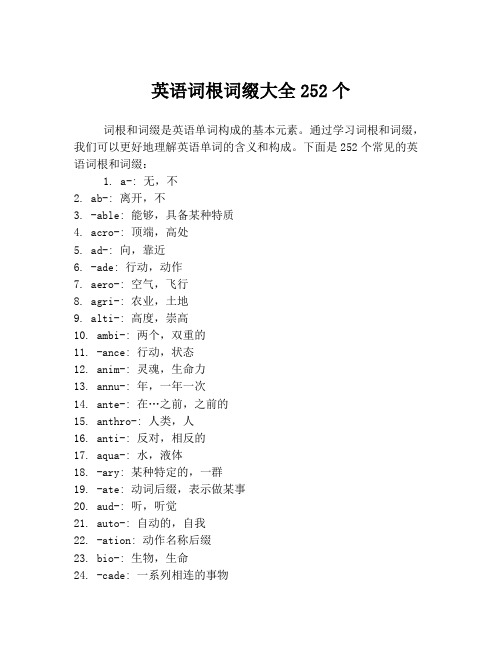
英语词根词缀大全252个词根和词缀是英语单词构成的基本元素。
通过学习词根和词缀,我们可以更好地理解英语单词的含义和构成。
下面是252个常见的英语词根和词缀:1. a-: 无,不2. ab-: 离开,不3. -able: 能够,具备某种特质4. acro-: 顶端,高处5. ad-: 向,靠近6. -ade: 行动,动作7. aero-: 空气,飞行8. agri-: 农业,土地9. alti-: 高度,崇高10. ambi-: 两个,双重的11. -ance: 行动,状态12. anim-: 灵魂,生命力13. annu-: 年,一年一次14. ante-: 在…之前,之前的15. anthro-: 人类,人16. anti-: 反对,相反的17. aqua-: 水,液体18. -ary: 某种特定的,一群19. -ate: 动词后缀,表示做某事20. aud-: 听,听觉21. auto-: 自动的,自我22. -ation: 动作名称后缀23. bio-: 生物,生命24. -cade: 一系列相连的事物25. cap-: 抓住,取得26. cardi-: 心,心脏27. cata-: 向下,完全28. -cele: 凸起,膨胀29. cent-: 一百30. -centric: 以…为中心,一种观点31. cephalo-: 头部,脑秆32. cerebro-: 大脑,智力33. -cidal: 杀死,杀人的,毁灭性的34. circum-: 围绕,周围35. -cide: 杀死,杀害36. co-: 共同,共享37. cogn-: 认知,知道38. com-: 共同的,共同存在的39. contra-: 反对的,相反的40. -cracy: 政府,国家41. -crat: 统治者,掌权者42. cred-: 信仰,信任43. -cyte: 细胞44. de-: 向下,从…中删除45. -debate: 战斗,搏斗46. dec-: 十47. demo-: 人民,民主的48. dendro-: 树木49. derm-: 皮肤,表皮50. di-: 两个,分裂的51. dia-: 通过,相互联系52. dict-: 说,命令53. dis-: 不,否定54. -dom: 支配,统治55. duo-: 两个,双重的56. dynam-: 力量,能量57. eco-: 生态,经济58. -ectomy: 切除,摘除59. -ed: 过去式后缀60. electr-: 电,电子61. en-: 加强,使成为62. -ent: 形容词后缀63. equi-: 平等的,相等的64. -er: 动词后缀,表示人或物质65. ethno-: 种族,民族66. eu-: 好,正常的67. ex-: 向外,使成为68. -ence: 名词后缀,表示状态69. extra-: 更多的,超出的70. fac-: 做,制造71. -fic: 做某事的,产生某种结果的72. -fy: 动词后缀,使成为73. -ful: 充满,拥有74. -genesis: 产生,发展75. geo-: 地球,地球上的76. -graphy: 描绘,研究77. -gyn-: 女性,女子78. -hood: 与…相关的状态或品质79. hydro-: 水,水力的80. hyper-: 超级,高于81. hypo-: 低于,下降82. -ia: 状况或病症83. -ian: 人,专家84. -ic: 形容词后缀85. -icist: 专家,学者86. -ician: 专家,从事某项职业的人87. -ics: 学科,学术88. idio-: 个人的,特有的89. inter-: 相互,之间90. intra-: 在内部,内部的91. -ious: 具有某种特质的,有…性的92. iso-: 同等的93. -ism: 主义,信仰94. -ist: 从事某项职业的人,专家95. ject-: 投掷,扔96. jud-: 判断,审判97. juven-: 年轻98. kilo-: 千,一千99. -kinesis: 运动,动作100. lab-: 劳动,工作101. lact-: 乳,产奶102. -lateral: 向一侧的103. leuco-: 白色,淡色104. lex-: 讲话,字词105. -logy: 学科,科学106. -lysis: 溶解,分解107. macro-: 大,巨大的108. magn-: 大,强大109. -mania: 痴迷,狂热110. -maniac: 疯狂的,狂热的111. -ment: 名词后缀,表示状态或行动112. meta-: 超越,元的113. meter-: 测量,计量114. micro-: 微小,小的115. mid-: 中间的,中央的116. milli-: 千分之一117. -misia: 憎恨,厌恶118. mono-: 单一的,一119. morph-: 形态,形状120. multi-: 多的,多种的121. -naut: 航行员,航天员122. neo-: 新的,现代的123. neph-: 肾,肾脏124. neuro-: 神经,神经系统125. noct-: 夜晚,夜间126. non-: 不是,没有127. nov-: 新的,新奇的128. -oic: 常见于形容词后缀129. -oid: 形状,形态130. oligo-: 少的,不足的131. omni-: 所有的,每一个的132. -ology: 学科,研究133. -oma: 肿瘤,肿块134. -onym: 名字,称呼135. ophthalm-: 眼,视力136. -or: 动词后缀,表示人或物品137. orch-: 睾丸,生殖器138. ortho-: 正常的,正确的139. oste-: 骨头,骨骼140. -ous: 具有某种性质的141. ox-: 牛,雄性的142. -pathy: 疾病,痛苦143. ped-: 脚,步行144. -pendent: 依靠,依赖145. peri-: 周围的,围绕着的146. -phil-: 爱好,喜欢147. -phobia: 害怕,抵触148. photo-: 光,照片149. -phyte: 植物150. phys-: 自然,自然环境151. -plasm: 细胞质152. -plasty: 修补,整形手术153. -plex: 复杂的,复杂的154. pneu-: 空气,呼吸155. -pod: 脚,足,某种生物156. -polis: 城市157. poly-: 多,多样的158. pon-: 放置,放置159. port-: 转移,运输160. post-: 在…之后,后缀161. pre-: 在…之前,预162. -press: 压制,压迫163. proto-: 第一,原始的164. pseud-: 假的,伪造的165. psych-: 心理,心灵166. pter-: 翅膀,飞行167. -ptosis: 下降,降低168. punct-: 刺穿,打孔169. quad-: 四,四边形的170. -scape: 景色,风景171. -scopy: 进行检查的过程172. semi-: 半,不完全173. -sis: 状态,过程174. -soma: 身体,细胞175. -sonic: 声音的,音响的176. spec-: 看,观看177. sperm-: 精子,生殖178. -sphere: 区域,领域179. -stasis: 停滞,静止180. -stat: 控制,稳定181. sub-: 在…下面,下面,次要的182. super-: 超级的,高于183. sym-: 一起,共同的184. syn-: 共同的,同步的185. -tact: 接触,触感186. -technic: 技巧,技艺187. tele-: 远程,远程的188. tempo-: 时间,节奏189. -tomy: 切开,割裂190. topo-: 地形,地形图191. tox-: 毒,毒素192. trans-: 转移,越过193. tri-: 三,三种194. -trophy: 生长,养分195. -tude: 态度,情绪196. ultra-: 超级的,极端的197. uni-: 一,单一的198. urban-: 城市,城区199. adip-: 脂肪,脂肪组织200. alg-: 疼痛,痛苦201. chromo-: 颜色,染色体202. chondro-: 软骨,软骨组织203. enter-: 肠,肠道204. -esis: 产生,发展205. ger-: 年老,衰老206. glyco-: 糖,糖分207. hemo-: 血液,血液的208. hepat-: 肝脏,肝脏病209. hier-: 神圣的,圣洁的210. hist-: 组织,组织学211. immun-: 免疫,免疫系统212. Irid-: 彩虹,虹膜213. lecith-: 卵磷脂214. -lyte: 盐215. lys-: 分解,溶解216. mast-: 乳房,乳腺217. myo-: 肌肉,肌肉的218. nephro-: 肾,肾脏219. neuro-: 神经,神经系统220. osteo-: 骨头,骨骼221. oto-: 耳朵,听觉222. phleb-: 静脉,静脉炎223. pulmo-: 肺部,肺的224. rhino-: 鼻子,鼻部225. sclero-: 硬的,硬化的226. sept-: 分隔,隔离227. soma-: 身体,细胞体228. thorac-: 胸膛,胸部229. thyr-: 甲状腺,甲状腺的230. tympan-: 鼓膜,耳膜231. ur-: 尿液,泌尿器官232. vas-: 血管,血液的233. ven-: 静脉,静脉的234. vid-: 看,视力235. vit-: 生命,养分236. xero-: 干的,干燥的237. zoo-: 动物,动物学的238. -philic: 爱…的,喜欢…的239. -phobic: 害怕…的,恐惧…的240. -poiesis: 制造,生成241. -plegia: 瘫痪,麻痹242. -pnea: 呼吸243. -ptysis: 咳嗽,咳出244. -rrhage: 出血,流血245. -rrhea: 流动,分泌246. -sandy: 砂的,沙的247. -spasm: 痉挛,抽搐248. -sthenia: 力量,体力249. -tripsy: 切开,割开250. -uria: 尿液,尿中的251. -yemia: 血液,血症252. -ytes: 细胞通过学习这些词根和词缀的含义,我们可以更好地理解单词的构成和含义,从而更好地掌握英语语言。
完整版英语词根词缀全表
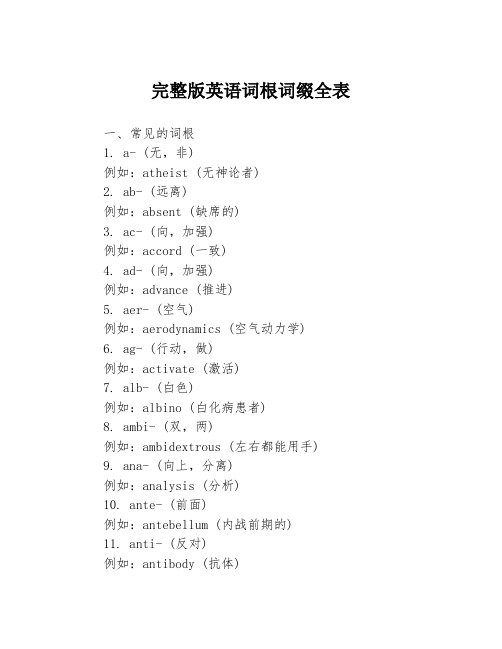
完整版英语词根词缀全表一、常见的词根1. a- (无,非)例如:atheist (无神论者)2. ab- (远离)例如:absent (缺席的)3. ac- (向,加强)例如:accord (一致)4. ad- (向,加强)例如:advance (推进)5. aer- (空气)例如:aerodynamics (空气动力学)6. ag- (行动,做)例如:activate (激活)7. alb- (白色)例如:albino (白化病患者)8. ambi- (双,两)例如:ambidextrous (左右都能用手)9. ana- (向上,分离)例如:analysis (分析)10. ante- (前面)例如:antebellum (内战前期的)11. anti- (反对)例如:antibody (抗体)12. apo- (离开,远离)例如:apology (道歉)13. aqua- (水)例如:aquarium (水族馆) 14. arch- (首席,最重要的) 例如:architect (建筑师) 15. audi- (听)例如:audience (观众)16. auto- (自动)例如:automatic (自动的) 17. belli- (战争)例如:bellicose (好战的) 18. bene- (好的)例如:benefit (好处)19. bi- (双)例如:bilateral (双边的) 20. bio- (生命)例如:biology (生物学) 21. brev- (短)例如:brevity (简短)22. cad- (落下)例如:cascade (瀑布)23. cap- (拿,抓)例如:capture (捕获)24. carn- (肉)例如:carnivore (食肉动物) 25. caus- (原因)例如:cause (原因)26. ced- (走,离开)例如:cede (放弃)27. cent- (百)例如:century (世纪)28. cep- (拿,抓)例如:reception (接待)29. cert- (确定)例如:certain (确定的)30. chron- (时间)例如:chronological (按时间顺序的) 31. circ- (圆,周围)例如:circle (圆)32. cis- (割,切)例如:incision (切口)33. civi- (城市)例如:civilization (文明)34. clam- (喊,叫)例如:proclamation (公告)35. cogn- (认识)例如:cognitive (认知的)36. col- (共同)例如:collaborate (合作)37. com- (一起)例如:combine (合并)38. contra- (反对)例如:contradict (反驳)39. corp- (身体)例如:corpse (尸体)40. cosm- (宇宙)例如:cosmic (宇宙的)41. counter- (反对)例如:counteract (抵消) 42. cred- (相信)例如:credibility (可信度) 43. crypt- (隐藏)例如:cryptic (神秘的) 44. cub- (立方体)例如:cubic (立方的)45. cumb- (躺)例如:recumbent (躺着的) 46. cycl- (圆圈)例如:cyclic (循环的)47. de- (向下)例如:decrease (减少)48. dec- (十)例如:decimal (十进制的) 49. dem- (人民)例如:democracy (民主) 50. dendr- (树状物)例如:dendrite (树突)51. dent- (牙齿)例如:dentist (牙医)52. derm- (皮肤)例如:dermatitis (皮炎)53. di- (两个)例如:diagonal (对角线)54. dia- (穿过)例如:diagonal (对角线)55. dict- (说)例如:predict (预测)56. dis- (分开)例如:disconnect (断开连接) 57. doc- (教)例如:document (文件)58. domin- (主人)例如:dominate (控制)59. don- (赠送)例如:donate (捐赠)60. dors- (背部)例如:dorsal (背部的)61. duc- (引导)例如:induce (诱导)62. dur- (坚固)例如:durable (耐用的)63. dyna- (能量)例如:dynamic (动态的)64. dys- (困难)例如:dysfunction (功能障碍) 65. e- (电子的)例如:electron (电子)66. eco- (环境)例如:ecology (生态学)67. ego- (自我)例如:egotistical (自大的) 68. em- (进入)例如:embed (嵌入)69. en- (使)例如:enable (使能够)70. end- (内部)例如:endocytosis (内吞作用) 71. equ- (相等)例如:equal (相等的)72. erg- (工作)例如:energy (能量)73. esth- (感觉)例如:aesthetic (美学的) 74. eu- (好的)例如:euphoria (欣快感)75. ex- (出,外)例如:exit (出口)76. extra- (超过)例如:extraordinary (非凡的) 77. fac- (使)例如:facilitate (促进)78. fall- (欺骗)例如:fallacy (谬论)79. fals- (错误)例如:false (虚假的)80. feder- (联邦)例如:federation (联邦制度) 81. fid- (信任)例如:confide (信任)82. fil- (线)例如:filament (灯丝)83. fin- (结束)例如:finish (完成)84. flex- (弯曲)例如:flexible (柔韧的) 85. flu- (流)例如:fluid (流体)86. foli- (叶)例如:foliage (叶子)87. forma- (形状)例如:formation (形成)88. fort- (强壮)例如:fortitude (坚忍)89. fract- (破碎)例如:fracture (骨折)90. frig- (冷)例如:refrigerator (冰箱) 91. fum- (烟)例如:fume (冒烟)92. fus- (融化)例如:fusion (熔合)93. gam- (婚姻)例如:gamete (配偶子)94. gastr- (胃)例如:gastric (胃的)95. gen- (种类)例如:generation (一代)96. geo- (地球)例如:geology (地质学)97. germ- (生命)例如:germination (发芽)98. giga- (十亿)例如:gigabyte (千兆字节)99. gloss- (光亮)例如:glossy (有光泽的)100. gluc- (糖)例如:glucose (葡萄糖)二、常见的词缀1. -able, -ible (能够,可被)例如:provable (可证明的), responsible (负责的) 2. -al (有关,属于)例如:federal (联邦的), cultural (文化的)3. -ance, -ence (动作或状态)例如:guidance (指导), persistence (坚持)4. -ant, -ent (有…的,做…的)例如:important (重要的), independent (独立的) 5. -ar, -er (具有…特征的)例如:familiar (熟悉的), harder (较难的)6. -ate (使…,成为…)例如:graduate (毕业), elaborate (详细阐述) 7. -ation (动作或状态)例如:education (教育), application (应用)8. -ed (过去式)例如:started (开始了), walked (走了)9. -en (使成为…)例如:fasten (系好), strengthen (增强)10. -er (比较级)例如:bigger (更大的), better (更好的)11. -est (最高级)例如:biggest (最大的), best (最好的)12. -ful (充满…的)例如:grateful (感激的), powerful (强大的) 13. -ic (有关… 的)例如:romantic (浪漫的), historic (历史性的) 14. -ify, -fy (使…,成为…)例如:intensify (加强), clarify (澄清)15. -ile (某种状态或特征)例如:versatile (多才多艺的), fragile (易碎的) 16. -ism (相信或追求…)例如:racism (种族主义), feminism (女权主义) 17. -ist (从事某种活动或专业的人)例如:dentist (牙医), scientist (科学家)18. -ite (居住在…)例如:Israelite (以色列人), meteorite (陨石) 19. -ity, -ty (表示状态或性质)例如:creativity (创造力), honesty (诚实)20. -ize (使成为…)例如:normalize (规范化), personalize (个性化)21. -less (没有…的)例如:thoughtless (没有思考的), useless (没用的)22. -logy (研究或学科)例如:biology (生物学), psychology (心理学)23. -ly (表示方式或状态)例如:quickly (迅速地), slowly (慢慢地)24. -ment (状态或过程)例如:improvement (改进), development (发展)25. -ness (具有…的状态)例如:happiness (幸福), illness (疾病)26. -ology (学科或研究)例如:biology (生物学), anthropology (人类学)27. -ous (含有…的)例如:famous (有名的), dangerous (危险的)28. -phobia (对…的恐惧)例如:arachnophobia (蜘蛛恐惧症), agoraphobia (广场恐惧症)29. -sis (状态或过程)例如:analysis (分析), diagnosis (诊断)30. -tic (有关…的)例如:neurotic (神经质的), athletic (运动员)31. -tion, -sion (动作或状态)例如:creation (创作), decision (决定)32. -y (状态或性质)例如:sleepy (困倦的), greedy (贪婪的)以上就是英语常见的词根和词缀,掌握它们有助于我们更好地理解和运用英语。
英语词根词缀大全
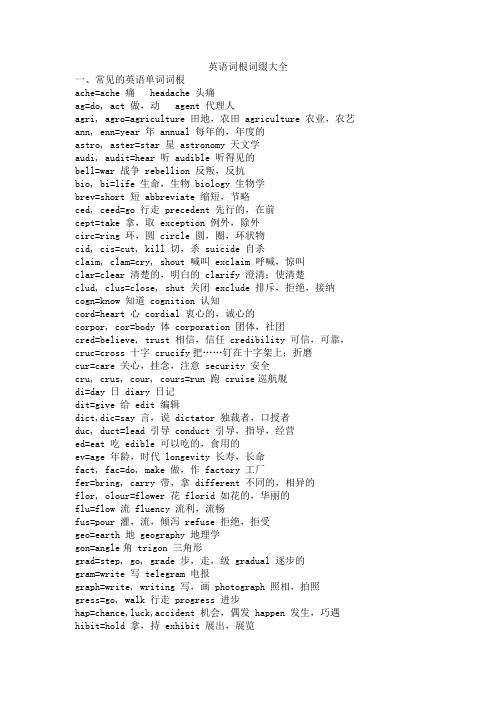
英语词根词缀大全一、常见的英语单词词根ache=ache 痛headache 头痛ag=do, act 做,动agent 代理人agri, agro=agriculture 田地,农田 agriculture 农业,农艺ann, enn=year 年 annual 每年的,年度的astro, aster=star 星 astronomy 天文学audi, audit=hear 听 audible 听得见的bell=war 战争 rebellion 反叛,反抗bio, bi=life 生命,生物 biology 生物学brev=short 短 abbreviate 缩短,节略ced, ceed=go 行走 precedent 先行的,在前cept=take 拿,取 exception 例外,除外circ=ring 环,圆 circle 圆,圈,环状物cid, cis=cut, kill 切,杀 suicide 自杀claim, clam=cry, shout 喊叫 exclaim 呼喊,惊叫clar=clear 清楚的,明白的 clarify 澄清;使清楚clud, clus=close, shut 关闭 exclude 排斥,拒绝,接纳cogn=know 知道 cognition 认知cord=heart 心 cordial 衷心的,诚心的corpor, cor=body 体 corporation 团体,社团cred=believe, trust 相信,信任 credibility 可信,可靠,cruc=cross 十字 crucify把……钉在十字桇上;折磨cur=care 关心,挂念,注意 security 安全cru, crus, cour, cours=run 跑 cruise巡航舰di=day 日 diary 日记dit=give 给 edit 编辑dict,dic=say 言,说 dictator 独裁者,口授者duc, duct=lead 引导 conduct 引导,指导,经营ed=eat 吃 edible 可以吃的,食用的ev=age 年龄,时代 longevity 长寿,长命fact, fac=do, make 做,作 factory 工厂fer=bring, carry 带,拿 different 不同的,相异的flor, olour=flower 花 florid 如花的,华丽的flu=flow 流 fluency 流利,流畅fus=pour 灌,流,倾泻 refuse 拒绝,拒受geo=earth 地 geography 地理学gon=angle角 trigon 三角形grad=step, go, grade 步,走,级 gradual 逐步的gram=write 写 telegram 电报graph=write, writing 写,画 photograph 照相,拍照gress=go, walk 行走 progress 进步hap=chance,luck,accident 机会,偶发 happen 发生,巧遇hibit=hold 拿,持 exhibit 展出,展览hospit, hosp=guest 客人 hospitable 好客的idio=particular, own, private, proper 特殊的,个人的,专有的 idiom 惯用语,方言insul=island 岛 insular 岛的,偏狭的it=go 行走 exit 出口,退出ject=throw 投掷 projection 投掷,发射lect, leg, lig=choose, gather 选,收 elect 选举lev=raise 举、升 elevate 抬起,使升高liber=liberty 自由 liberation 解放lingu=language 语言 linguist 语言专家liter=letter 文字,字母 literate 识字的,有文化的loc=place 地方 local 当地的log=speak 言,说 dialogue 对话loqu=speak 言说 eloquent 有口才的,雄辩的lun=moon 月亮 lunar 月亮的,似月的manu, man=hand 手 manuscript 手稿mar=sea 海 marine 海上的,航海的medi=middle 中间 mediate 居中调解,调停memor=memory,mindful 记忆,记住的 memory 记忆,记忆力milit=soldier 兵 military 军事的,军队的mini=small,less 小 minimum 最小数mir=wonder 惊奇,惊异 admire 赞赏,钦佩mort=death 死 mortal 终有一死的mot=move 移动 motion 运动,动nomin=name 名 nominal 名义上的,有名无实的nov=new 新 novel 新的,新奇的numer=number 数 numeral 数字,[语]数词oper=work 工作 operation 手术,工作,操作ori=rise 升起 orient 东方,东方的paci=peace 和平 pacify 使和平,抚慰past=feed 喂,食 pasture 放牧、牧场,吃草pel=push, drive 推,逐,驱 propel 推动pend, pens=hang 悬挂 pendent 悬空的,悬而未决的pet=seek 追求 compete 竞争,比赛phon=sound 声音 phone 电话plen=full 满,全 plenty 大量,丰富pone=put 放置 postpone 推后,推迟popul=people 人民 population 人口,全体居民port=carry 拿,带,运 import 输入,进口pos=put 放置 expose 揭露,揭发preci=price 价值 precious 宝贵的,珍贵的pur=pure 清,纯 purify 使纯净rect=right, straight 正,直 correct 改正,纠正rupt=break 破 rupture 破裂,使裂开sal=salt 盐 salary 薪水sci=know 知 science 科学sec, sequ=follow 跟随 sequence 继续,连续sect=cut 切割 section 切开,一部分sent, sens=feel 感觉 sentiment 感情,思想感情son=sound 声音 sonic 声音的,音速的spect=look 看 spectate 出席,观看spir=breathe 呼吸 inspire 鼓舞,吸入tail=cut 切,割 tailor 裁缝,成衣商tain, ten=hold 握,持,守 contain 容纳,包含,内装tect=cover 掩盖 detect 侦查,发觉tempor=time 时 temporary 暂时的,临时的tend, tens=draw 拉 tension 拉紧,引力tent, tract=draw 拉,抽,引 tractor 拖拉机urb=city 城市 suburb 郊区,近郊ut=use 用 utility 效用, 有用vac, vacu=empty 空 vacancy 空白,空虚vad, vas=walk, go 行走 invasion 入侵,侵略vari=change 变化 variable 可变的,反复的ven=come 来 convene 召集(会议),集会vert, vers=turn 转 subvert 推翻,颠覆vi, via=way 路 via 取道,经由vis, vid=see 看 visible 可见的,看得见的vit=life 生命 vital 充满活力的viv=live 活 vivid 活泼的,有生气的二、常见的英语单词前缀cor- =① together, correlation 相互关系, corradiate 使(光线)共聚于一点, correspond 符合,相应②加强或引伸意义, correct 改正,纠正, corrupt 腐败,败坏, corrugate 使起皱纹counter- = opposite, counterrevolutionary 反动的, countermeasure 对策,应策, countercurrent 逆流, countermarch 反方向行进, counterattack 反攻,反击, countercharge 反控,反告de- =① down from, deplane 下飞机, dethrone 使离王位, derail 使(火车)脱轨②向下、降低、减少, depress 压低,压下, depopulation 人口减少, devalue 贬值③使成...,作成...,或仅作加强意义, delimit 划定界限, denude 使裸露, depicture 描绘,描述④not, denationalize 非国有化, demilitarize 使非军事化, demobilize 复员⑤除去、取消、毁, desalt 除去盐份, deforest 砍伐森林, decontrol 取消管制dec(a)- = ten, decade 十年, decimal 十进位制的, decathlon 十项全能deci- =十分之一, decigram 十分之一克, decimeter 十分之一米, decilitre 十分之一升demi- = 半, demigod 半神半人, demi-fixed 半固定的, demiwolf 半似狼之犬di- = 二、双, diatomic 二原子的, disyllable 双音节词, dichromatic 两色的dia- = through;between;across , diameter 直径, dialogue 对话, diagnosis 诊断dif- = 1)apart. 2)not;opposite , diffluence 分流, diffident 不自信的, dismember 解体, diffuse 散开,散布dis- = ①不、无、相反, dislike 不喜欢, disagree 不同意, discontinue 中断, disorder 混乱, disbelieve 不信, disproof 反证, dishonest 不诚实的, dispraise 贬损,非难, disappear 消失, disremember 忘记, discomfort 不舒服, disability 无能,无力②加在含有分开、否定等意义的单词前,作加强意义, dispart 分离,裂开, dissever 分裂,切断, dissemination 散布,传播③分开、离、散, dissect 切开, dissolve 分离,溶解, distract 分心,转移, dispense 分配, dispel 驱散, dissipate 驱散,浪费④有时作di-,, dispirit 使气馁,使沮丧, divorce 离婚, digress 离正题,入歧路dys- = 不良、恶、困难, dysfunction (医)机能失调,功能紊乱, dysphonia 发音困难, dyspepsia 消化不良, dyspathy 反感, dysgenesis 生殖障碍, dysopsy 弱视e- =① 加强或引伸意义, evaluate 评价, elongate 使延长,拉长, estop 阻止,禁止, estrange 使疏远, evanish 消失, elaborate 精心制作,详细描述②出、外, eject 投出,掷出, emigrate 移居国外, elect 选出, emerge 浮出,出现, erupt 喷出, evade 逃出ef- =出、离去, effluence 流出, effable 能被说出的, effoliation 落叶em- =①表示置于...之内、上..., embay 使(船)入湾, embus 上车,装入车中, embosom 藏于胸中,怀抱, emplane 乘飞机, embed 安置, embog 使陷于泥沼中②表示用...做某事、饰以...、配以..., embalm 涂以香料(防腐剂), embank 筑堤防护, embar 上门闩,囚禁③表示使成某种状态、致使...、使之如...、作成..., embow 使成弓形, empower 使有权力,授权, empurple 使发紫, embody 体现,使具体化, embitter 使受苦, embrown 使成褐色eco- = ecological, ecosphere 生态圈, ecosystem 生态系统, ecocide 生态灭绝en- =①表示置于..之中、登上...、使上..., entrain 乘火车, encage 关入笼中, encase 装入, enplane 乘飞机, encave 藏于洞中, enroll 登记,记入名册中, enthrone 使登基, enshrine 藏于神龛中, enfold 包进、拥抱②make or cause to be,使成某种状态、致使...、使之如...、作成..., enable 使能够, endanger 使受危险, enlighten 启发,启蒙, enlarge 扩大,放大, enrich 使富足, enslave 使成奴隶,奴役③用...来做某事、饰以...、配以..., enchain 用链锁住, enlace 用带缚, entrap 诱陷④加在动词之前,表示in,或只作加强意义, enclose 围入,关进, entrust信任,委托, enforce 强制执行, enkindle 点火, enwrap 包入,卷入, enhearten 鼓舞,振奋endo- =内, endoparasite 体内寄生虫, endogamy (同族)内部通婚, endogen 内生植物eu- =good;well;easy, eugenica 优生学, eulogize 赞美, euphemism 委婉语, euphonic 声音优美的, eupepsia 消化良好, euthenics 优境学ex- =①out;out of, exclusive 不包括...的, expose 揭露, emit 发射出, export 出口,输出, exclude 排外,排斥, excavate 挖出,挖掘, exit 出口, extract 抽出,拔出, exhume 掘出②前任的、以前的, ex-president 前任总统, ex-Nazis 前纳粹分子, ex-mayor 前任市长, ex-chancellor 前任大学校长, ex-premier 前任总理, ex-wife 前妻③表示使、做,或作加强意义, expurgate 使清洁, exalt 使升高,增高, excruciate 施刑,使苦dis- == 取消、除去、毁, disorganize 瓦解, disroot 根除, discourage 使失去勇气, disrobe 脱衣, disarm 解除武装,裁军, dishearten 使失去信心, disburden 解除负担, discolor 使褪色,表示否定意义的前缀常用的有dis-, il-, im-, in-, ir-, mis-, non-, un-等,在单词的前面加这类前缀常构成与该词意义相反的新词。
常用英语词根词缀分类表
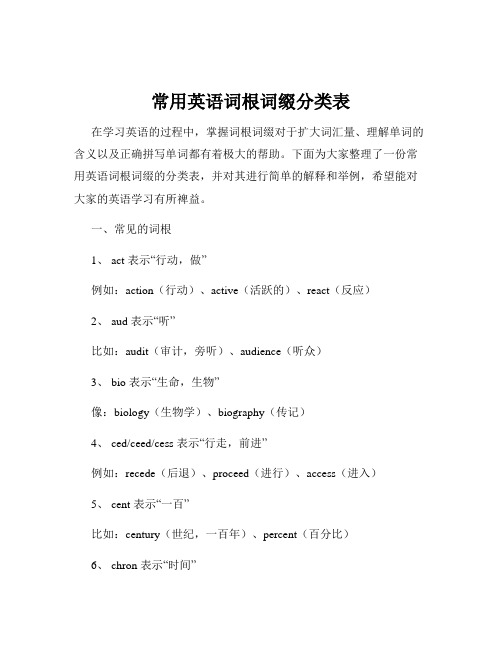
常用英语词根词缀分类表在学习英语的过程中,掌握词根词缀对于扩大词汇量、理解单词的含义以及正确拼写单词都有着极大的帮助。
下面为大家整理了一份常用英语词根词缀的分类表,并对其进行简单的解释和举例,希望能对大家的英语学习有所裨益。
一、常见的词根1、 act 表示“行动,做”例如:action(行动)、active(活跃的)、react(反应)2、 aud 表示“听”比如:audit(审计,旁听)、audience(听众)3、 bio 表示“生命,生物”像:biology(生物学)、biography(传记)4、 ced/ceed/cess 表示“行走,前进”例如:recede(后退)、proceed(进行)、access(进入)5、 cent 表示“一百”比如:century(世纪,一百年)、percent(百分比)6、 chron 表示“时间”像:chronicle(编年史)、chronological(按时间顺序的)7、 cid/cis 表示“切,杀”例如:decide(决定)、suicide(自杀)8、 clar 表示“清楚,明白”比如:clarify(澄清)、clarity(清晰)9、 corp/corpor 表示“身体,团体”像:corporation(公司)、corporeal(肉体的)10、 cred 表示“相信,信任”例如:credit(信用)、credible(可信的)二、常见的前缀1、 a 表示“在……之上,向……”比如:aboard(在船上)、aside(在旁边)2、 ab 表示“离开,相反”像:abnormal(反常的)、abuse(滥用)3、 anti 表示“反对,相反”例如:antibody(抗体)、antifreeze(防冻剂)4、 auto 表示“自己,自动”比如:automatic(自动的)、autobiography(自传)5、 be 表示“使……,在……”像:beloved(心爱的)、befall(降临)6、 bi 表示“两个,双”例如:bicycle(自行车)、bilingual(双语的)7、 co/com/con 表示“共同,一起”比如:cooperate(合作)、compose(组成)、concentrate(集中)8、 de 表示“向下,除去,否定”像:decrease(减少)、decode(解码)、deform(使变形)9、 dis 表示“不,相反,除去”例如:dislike(不喜欢)、disappear(消失)、disarm(解除武装)10、 em/en 表示“使……,进入”比如:embrace(拥抱)、enable(使能够)11、 ex 表示“出,向外”像:export(出口)、exclude(排除)12、 extra 表示“以外,超过”例如:extraordinary(非凡的)、extracurricular(课外的)13、 fore 表示“在前面,预先”比如:forehead(前额)、forecast(预测)14、 in/im 表示“不,无,向内”像:incorrect(不正确的)、impossible(不可能的)、import(进口)15、 inter 表示“在……之间,相互”例如:interview(面试,面谈)、international(国际的)16、 mis 表示“错误,坏”比如:mistake(错误)、misunderstand(误解)17、 multi 表示“多”像:multiply(乘,增加)、multicultural(多元文化的)18、 non 表示“非,不”例如:nonstop(不停的)、nonprofit(非营利的)19、 over 表示“过度,在……之上”比如:overtime(加班)、overcome(克服)20、 peri 表示“周围,环绕”像:perimeter(周长)、periphery(边缘)三、常见的后缀1、 able/ible 表示“可……的,能……的”例如:readable(可读的)、visible(可见的)2、 al 表示“……的,关于……”比如:national(国家的)、natural(自然的)3、 an/ian 表示“……的,属于……的”像:American(美国的)、musician(音乐家)4、 ance/ence 表示“性质,状况”例如:appearance(出现)、difference(不同)5、 ant/ent 表示“……的,……者”比如:important(重要的)、student(学生)6、 ary/ory 表示“……的,与……有关的”像:library(图书馆)、factory(工厂)7、 ate 表示“做,使……”例如:graduate(毕业)、create(创造)8、 cy 表示“性质,状态”比如:accuracy(准确性)、privacy(隐私)9、 dom 表示“领域,状态,身份”像:freedom(自由)、kingdom(王国)10、 ee 表示“动作的承受者”例如:employee(雇员)、refugee(难民)11、 er/or 表示“……者”比如:teacher(教师)、actor(演员)12、 ess 表示“女性”像:actress(女演员)、hostess(女主人)13、 ful 表示“充满……的”例如:careful(小心的)、useful(有用的)14、 hood 表示“身份,状态,时期”比如:childhood(童年)、neighborhood(邻里)15、 ic/ical 表示“……的”像:historic(历史的)、economic(经济的)16、 ion/tion/sion 表示“动作,状态”例如:action(行动)、education(教育)、conclusion(结论)17、 ive 表示“……的,有……倾向的”比如:active(活跃的)、creative(有创造力的)18、 less 表示“无,没有”像:careless(粗心的)、homeless(无家可归的)19、 ment 表示“行为,结果”例如:development(发展)、agreement(同意)20、 ness 表示“性质,状态”比如:happiness(幸福)、kindness(善良)通过对这些常见的词根词缀的学习和掌握,我们可以更加轻松地理解和记忆英语单词,同时也能够根据已知的词根词缀推测出陌生单词的大致含义。
高中英语词缀词根大全

高中英语词缀词根大全英语词缀和词根是构成单词的基础部分,掌握这些词缀和词根可以帮助我们更好地理解和记忆单词的意思。
在高中英语学习中,词缀词根的学习尤为重要,因为它们可以帮助我们扩大词汇量,提高阅读和写作能力。
下面是一份高中英语词缀词根大全,希望能帮助你更好地学习英语。
1. -able/-ible:表示“能够被…”,例如:comfortable(舒适的)、visible(可见的)。
2. -al/-ial:表示“与…相关的”,例如:cultural(文化的)、financial(金融的)。
3. -ance/-ence:表示“状态或行为”,例如:importance(重要性)、difference(不同)。
4. -ate:表示“使…”,例如:educate(教育)、communicate(交流)。
5. -ful:表示“充满…的”,例如:helpful(有帮助的)、beautiful(美丽的)。
6. -ic/-ical:表示“关于…的”,例如:scientific(科学的)、historical(历史的)。
7. -ify/-fy:表示“使…”,例如:simplify(简化)、classify(分类)。
8. -ist:表示“从事某种职业的人”,例如:scientist(科学家)、journalist(记者)。
9. -less:表示“没有…的”,例如:hopeless(没有希望的)、fearless(无畏的)。
10. -ment:表示“行为或结果”,例如:achievement(成就)、development(发展)。
11. -ness:表示“状态或质量”,例如:happiness(幸福)、kindness(善良)。
12. -ous:表示“充满…的”,例如:famous(著名的)、dangerous(危险的)。
13. -ship:表示“关系或状态”,例如:friendship(友谊)、leadership(领导能力)。
英语常见252个词根
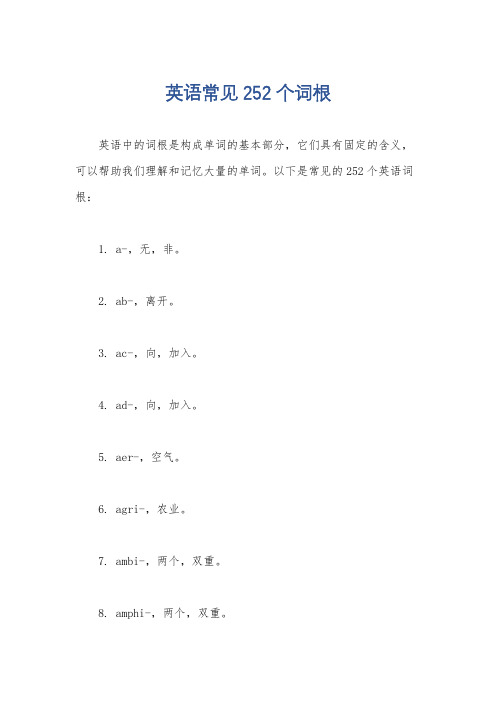
英语常见252个词根英语中的词根是构成单词的基本部分,它们具有固定的含义,可以帮助我们理解和记忆大量的单词。
以下是常见的252个英语词根:1. a-,无,非。
2. ab-,离开。
3. ac-,向,加入。
4. ad-,向,加入。
5. aer-,空气。
6. agri-,农业。
7. ambi-,两个,双重。
8. amphi-,两个,双重。
9. ana-,分离,向上。
10. andro-,男性。
11. angio-,血管。
12. ante-,前。
13. anti-,反对,对抗。
14. aqua-,水。
15. arch-,首要,最重要的。
16. astro-,星星。
17. audi-,听。
18. auto-,自动,自我。
19. bene-,好,善良。
20. bi-,两个。
21. bio-,生命。
22. blast-,发芽,生长。
23. cardi-,心脏。
24. cent-,百。
25. chrom-,颜色。
26. chron-,时间。
27. circ-,环形,循环。
28. co-,共同。
29. com-,共同。
30. con-,共同。
31. contra-,相反。
32. corp-,身体。
33. cosm-,宇宙。
34. counter-,反对,相反。
35. cranio-,头骨。
36. crypto-,隐藏的。
37. cycl-,圆,循环。
38. de-,去掉,除去。
39. dec-,十。
40. dem-,人民。
41. derm-,皮肤。
42. di-,两个。
43. dia-,穿过,通过。
44. dis-,分开。
45. dom-,领域,状态。
46. e-,电子。
47. eco-,环境。
48. electro-,电。
49. endo-,内部。
50. epi-,在…之上。
51. equi-,相等。
52. ex-,出,外。
53. extra-,额外的,超出。
54. fer-,带来,携带。
55. fin-,结束,完成。
英语常用词根词缀表
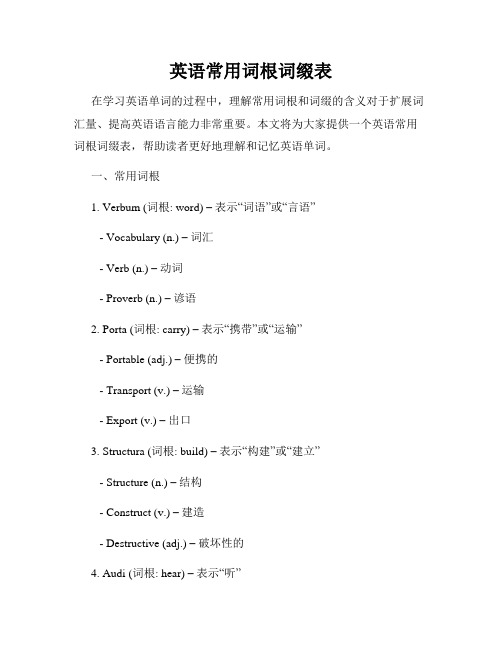
英语常用词根词缀表在学习英语单词的过程中,理解常用词根和词缀的含义对于扩展词汇量、提高英语语言能力非常重要。
本文将为大家提供一个英语常用词根词缀表,帮助读者更好地理解和记忆英语单词。
一、常用词根1. Verbum (词根: word) –表示“词语”或“言语”- Vocabulary (n.) –词汇- Verb (n.) –动词- Proverb (n.) –谚语2. Porta (词根: carry) –表示“携带”或“运输”- Portable (adj.) –便携的- Transport (v.) –运输- Export (v.) –出口3. Structura (词根: build) –表示“构建”或“建立”- Structure (n.) –结构- Construct (v.) –建造- Destructive (adj.) –破坏性的4. Audi (词根: hear) –表示“听”- Auditory (adj.) –听觉的- Audience (n.) –观众- Audible (adj.) –可听见的5. Photos (词根: light) –表示“光”- Photograph (n.) –照片- Photon (n.) –光子- Photosynthesis (n.) –光合作用6. Tele (词根: far) –表示“远”- Telephone (n.) –电话- Television (n.) –电视- Telecommunication (n.) –电信7. Chronos (词根: time) –表示“时间” - Chronological (adj.) –按时间顺序的 - Synchronize (v.) –同步- Chronic (adj.) –慢性的8. Bio (词根: life) –表示“生命”- Biology (n.) –生物学- Biography (n.) –传记- Biodiversity (n.) –生物多样性二、常用词缀1. -able/-ible –表示“可…”或“能…”- Comfortable (adj.) –舒适的- Convertible (adj.) –可转换的- Incredible (adj.) –难以置信的2. -er/-or –表示“做…”或“与…有关” - Teacher (n.) –教师- Actor (n.) –演员- Calculator (n.) –计算器3. -ful –表示“充满…”或“有…”的特点 - Beautiful (adj.) –美丽的- Careful (adj.) –仔细的- Helpful (adj.) –有帮助的4. -less –表示“没有…”或“缺乏…”- Sleepless (adj.) –不眠的- Fearless (adj.) –无畏的- Endless (adj.) –无尽的5. -ment –表示“行为”或“状态”- Treatment (n.) –治疗- Development (n.) –发展- Agreement (n.) –协议6. -ism –表示“信仰”或“思想体系”- Capitalism (n.) –资本主义- Socialism (n.) –社会主义- Feminism (n.) –女权主义7. -able/-ible –表示“被…”或“可以…”- Enjoyable (adj.) –令人愉快的- Understandable (adj.) –可理解的- Accessible (adj.) –可访问的三、总结通过掌握常用词根和词缀,我们可以更好地推测和理解单词的词义,拓展我们的词汇量。
- 1、下载文档前请自行甄别文档内容的完整性,平台不提供额外的编辑、内容补充、找答案等附加服务。
- 2、"仅部分预览"的文档,不可在线预览部分如存在完整性等问题,可反馈申请退款(可完整预览的文档不适用该条件!)。
- 3、如文档侵犯您的权益,请联系客服反馈,我们会尽快为您处理(人工客服工作时间:9:00-18:30)。
主题: 英语构词法一些常用的词缀和词根掌握一些英语构词法,对单词的记忆和理解有很大的帮助,下面笔者列举一些常用的词缀和词根。
一. 常见的前缀1.表示否定意义的前缀1)纯否定前缀a-, an-, asymmetry(不对称)anhydrous(无水的)dis- dishonest, dislikein-, ig-, il, im, ir, incapable, inability, ignoble, impossible, immoral, illegal, irregularne-, n-, none, neither, nevernon-, noesenseneg-, neglectun- unable, unemployment2)表示错误的意义male-, mal-, malfunction, maladjustment(失调)mis-, mistake, misleadpseudo-, pseudonym(假名), pseudoscience3)表示反动作的意思de-, defend, demodulation(解调)dis-, disarm, disconnectun-, unload, uncover4)表示相反,相互对立意思anti-, ant- antiknock( 防震), antiforeign,(排外的)contra-, contre-, contro-, contradiction, controflow(逆流)counter-, counterreaction, counterbalanceob-, oc-, of-, op-, object, oppose, occupywith-, withdraw, withstand2. 表示空间位置,方向关系的前缀1)a- 表示“在……之上”,“向……”aboard, aside,2)by- 表示“附近,邻近,边侧”bypath, bypass(弯路)3)circum-, circu-, 表示“周围,环绕,回转”circumstance, circuit4)de-, 表示“在下,向下”descend, degrade5)en-, 表示“在内,进入”encage, enbed(上床)6)ex-, ec-, es-, 表示“外部,外”exit, eclipse, expand, export7)extra-, 表示“额外”extraction (提取)8)fore- 表示“在前面”forehead, foreground9)in-, il-, im-, ir-, 表示“向内,在内,背于”inland, invade, inside, import10)inter-, intel-, 表示“在……间,相互”international, interaction, internet11)intro-, 表示“向内,在内,内侧”introduce, introduce12)medi-, med-, mid-, 表示“中,中间”Mediterranean, midposition13)out-, 表示“在上面,在外部,在外”outline, outside, outward14)over-, 表示“在上面,在外部,向上”overlook, overhead, overboard15)post-, 表示"向后,在后边,次”postscript(附言),16)pre-, 表示"在前”在前面”prefix, preface, preposition17)pro-, 表示“在前,向前”progress, proceed,18)sub-, suc-, suf-, sug-, sum-, sup-, sur-, sus-, 表示“在下面,下”subway, submarine, suffix, suppress, supplement19)super-, sur-, 表示“在…..之上”superficial, surface, superstructure20)trans-, 表示“移上,转上,在那一边”translate, transform, transoceanic21)under-, 表示“在…..下面,下的”underline, underground, underwater22)up-, 表示“向上,向上面,在上”upward, uphold, uphill(上坡)3. 表示时间,序列关系的前缀1)ante-, anti-, 表示“先前,早于,预先”antecedent, anticipate,2)ex-, 表示“先,故,旧”expresident, exhu我的好友and3)fore-, 表示“在前面,先前,前面”foreward, dorecast, foretell(预言)4)mid-, medi-, 表示“中,中间”midnight, midsummer5)post-"表示“在后,后”postwar,6)pre-, pri-, 表示“在前,事先,预先”preheat, prewar, prehistory7)pro-, 表示“在前,先,前”prologue(序幕),prophet(预言家)8)re-, 表示“再一次,重新”retell, rewrite4. 表示比较程度差别关系的前缀1)by-, 表示“副,次要的”byproduct, bywork(副业)2)extra-,表示“超越,额外”extraordinary,3)hyper- 表示“超过,极度”hypersonic(超声波), hypertesion(高血压)4)out-,表示“超过,过分”outdo(超过), outbid(出价过高的人)5)over-,表示“超过,过度,太”overeat, overdress, oversleep6) sub-, suc-, sur-, 表示“低,次,副,亚”subeditor, subordinate, subtropical(亚热带)7)super-, sur- 表示“超过”supernature, superpower, surplus, surpass8)under-,表示“低劣,低下”undersize, undergrown, underproduction(生产不足)9)vice- 表示“副,次”vicepresident, vicechairman5. 表示共同,相等意思的前缀1)com-, cop-, con-, cor-, co- 表示“共同,一起”。
connect, combine, collect, combat, coexist, co-operate 2)syn-, syl-,sym-,表示“同,共,和,类”symmetry, sympathy, synthesis(合成)6. 表示整个完全意思的前缀1)al- 表示“完整,完全”alone, almost,2) over-表示“完全,全”overall, overflow(充满)3) pan-表示“全,总,万”panentheism(泛神论),panorama7. 表示分离,离开意思的前缀1)a- ab-, abs-,表示“分离,离开” away, apart, abstract, abstain2)de- 表示“离去,处去”depart, decolour,3)dis-, di-, dif-, 表示“分离,离开” divorce, disarm(缴械)4)ex-, e-, 表示“离开,分离”expel, exclude, expatriate(驱出国外)5)for- 表示“离开,脱离”forget, forgive6)表示“离开”release, resolve7)表示“分离,隔离”separate, seduce, select8. 表示通过,遍及意思的前缀1)dia-,表示“通过,横过”diameter, diagram,2)per-, pel-, 表示“通,总,遍”perfect, perform, pervade(浸透)3)trans-, 表示“横过,贯通”transparent, transmit, transport9. 表示加强意思的前缀a-, arouse, ashamedad-, adjoin, adhere( 粘着)10. 表示变换词类作用的前缀be-, befriend,en-, enslave, enable, enrichad-, ac-, af-, ag-, an-, ap-, ar-, as-, at-, adapt, accord, affix, aggression, arrive, assist, attend, attract, arrange, assign(委派)11. 表示数量关系的前缀1)表示“单一”,“一”mon-, mon-, monotone(单调),monopoly, monarchuni-, un-, uniform, unicellular(单细胞)2)表示“二,两,双”ambi-, ambiguous, amphibian(两栖类)bi-, bin- bicycle, di-, diode(二级管),twi-, twilight3)表示“十”deca, deco-, dec- deci-, decade, decimals4)表示"百,百分子一"hecto-, hect-, hectometer,centi-, centimeter5)表示"千,千分子一” kilo-, kilometer6)表示"万,万分子一”myria-, myri-, myriametremega-, meg-, megabytemicro-, microvolt (微伏特)7)表示"许多,复,多数”multi-, mult-, multipmetre (万用表)poly-, polysyllable,8)表示“半,一半”hemi-, hemispheredemi-, demiofficialsemi-, semiconductor, semitransparentpene-, pen-, peninsula12. 表示特殊意义的前缀1)arch-, 表示“首位,第一的,主要的”architect, archbishop2)auto-, 表示“自己,独立,自动”automobile, autobiography3)bene-, 表示“善,福”benefit4)eu-, 表示“优,美好”eugenics(优生学),euphemism5)male-, mal- 表示“恶,不良”maltreatment, malodor,6)macro-, 表示“大,宏大”macroscopic(宏观)7)magni-, 表示“大”magnificent8)micro-, 表示“微”microscope13. 表示术语的前缀1)aud-, 表示“听,声”audience,2)bio-, 表示“生命,生物”biography(传记)3)ge-, 表示“地球,大地”geography4)phon-, 表示“声,音调”phonograph5)tele-, 表示“远离”television, telephone词根词汇表ambi 两个都(来自拉丁文)ambidextrous 左右手都很灵巧的ambiguity 含糊,不明确ambiguous 模糊的,不明确的ambivalence正反感情并存,心情矛盾的ambul to walkambulatoryambleambulancesomnambulistamphi 双边的,四周的(来自希腊语)amphibian adj.两栖类的, 水陆两用的 n.两栖动物, 水陆两用飞机, 水陆两用的平底车辆amphibious两栖的amphibology模棱两可的言辞, 暧昧的词句amphipod片脚类动物amphitheatre阶梯教室(美作:amphitheater) 圆形剧场anni, annu 年(来自拉丁文)annals 年鉴anniversary 周年纪念annual 每年一次的 (=yearly)annual ring 年轮annually 每年一次地biannual 每年两次的biennial 每两年一次的centennial 百年的triannual 每年三次的triennial 每三年一次的ante beforeanteroomantebellumantedateantecedentantediluviananti 反,消解(来自希腊语)anti-aircraft 防空的antiballistic missile 反弹道导弹antibiosis 抗生antibody 抗体anticlerical 反对教会权利的anticlimax 突降法anticlockwise 逆时针的anticyclone 反气旋antidepressant 抗抑郁的antidote 解毒药antifreeze n. 防冻剂antigen 抗原antihero 反主角antilogy 思想、用语前后矛盾antimagnetic 防磁的antimalarial 抗疟疾的antimatter 反物质antimissile 反导弹的antinovel 非正统派小说antiparticle 反粒子antipathy 憎恶,反感antipode正相反的事物anti-Semite反犹份子antisocial不擅社交的, 非社交的, 反社会的antithesis对立面,立论antitoxin抗毒素antitrust反托拉斯aqua 水(来自拉丁文)aquaculture水产业aqualung水中呼吸器,水肺aquamarine绿玉, 碧绿色,海蓝色aquanaut轻装潜水员aquaplane 滑水板aquarium 水族馆,养鱼缸aquatic 生长于水边或水中的aqueduct 输水道aqueous 水的,像水的aquiculture 水栽培-arch 领导者anarchymonarchpatriarch/cgi/i ... amp;HIGHLIGHT=archy astro 星星(来自希腊语)asterisk星号asteroid小行星 adj.星状的astrobiology天体生物学, 太空生物学astrodome天体观测窗astrolabe古代的天体观测仪, 星盘astrology占星术astronaut太空人, 宇航员astronautics太空航空学astronomer天文学家astronomy天文学astrophysics 天体物理学audi to hearaudienceauditoryaudibleauditoriumaudiovisualauditionauto selfautomobileautomaticautographautonomousautoimmunebene 好,有益(来自拉丁文)benedict原来似乎坚决抱独身主义而新近结婚的男子benediction 祝祷,恩赐benefaction 捐助benefactor恩人, 捐助者, 赠送者, 赞助人benefactress女施主, 女恩人benefice 圣俸,有俸之圣职beneficence 善行,仁慈,慈善beneficent 慈善的,仁慈的beneficial 有益的beneficiary 受惠者benefit 利益benevolence 仁爱,善行benevolent 慈善,仁慈的benign 良性,良好,亲切的benignant 仁慈,亲切的bi, di, 二,双(其中bi来自拉丁文,di则是经由希腊语传入拉丁文的)biannualbicameralbicentenarybicephalousbicepsbichloride=dichloridebicolourbicyclebiennialbifocalbifurcatebigamybilabialbilateralbilingualbimannualbimonthlybinary notation or systembinary starbinauralbinocularsbinomialbipartisanbipartitebipedbipolarbisectbisexualbisulphide=disulphidebivalent=divalentbiweeklybiyearlydichloride dichlorodiphenyltrichloroethane DDT dichotomydichromaticdifferdifferencedifferentiatediglyceridesdigraphdilemmadioxidediphthongdivergedividedivorcebiblio 书(来自希腊语)bibliography 参考文献,书目bibliomania 嗜书如狂bibliophile 书籍收藏者,或喜爱书籍者bibliophole 书商,尤其是经营珍本者bio 生命(来自希腊语)bioastronauticsbiochemistrybiocidebiocoenosisbiodegradablebioengineeringbioethicsbiographybiologybiological clockbiological controlbiological warfarebiomedicinebiometrybionicsbionomics a less common name for ecology biophysicsbiopsybiosynthesisbiotechnologybioticcent (由拉丁语传至法语传至英语)bicentenarybicentennialcentcentenarycentigradecentimetercentipedecenturytricentennialchrom 色彩,颜色(来自希腊语)chromaticchromaticschromechrome yellowchromolighographchromosomechromospheremonochromechrono 时间(来自希腊语)anachronismchronicchroniclechronographchronologychronometercide 杀,死亡(来自拉丁文)aborticideacaricidealgicideamicicideavicidebactericidebiocidebovicideceticidecimicidedeicideecocideepiscopicidefelicidefemicidefeticidefilicidefilicidefoeticideformicidefratricidefungicidegenocidegermicidegiganticidegynaecideherbicidehomicideinfanticideinsecticidelupicidemariticidematricidemiticidemuscicideovicideparasiticideparasuicideparenticidepatricidepesticideprolicideraticideregiciderodenticidesenicideserpenticidesiblicidesororicidespeciocidesuicidetyrannicideurbicideursicideverbicidevulpicideweedicidecircus 圆环,圆圈;circum 四周(两者都来自拉丁文,后者又是来自前者,故列在一起)circlecircletcircuitcircuitouscircularcirculatecirculationcircumambientcircumambulatecircumcisecircumferencecircumfluouscircumfusecircumlocution 婉转曲折的说法circumnavigatecircumscribe 限制,立界限circumspect 慎重,小心的circumstance 情况circumstantial 不重要,间接,推论的circumvent包围,胜过contra, contro, counter 相反(来自拉丁文)contraception避孕, 避孕法contradict 否认,矛盾contrary 相反的contrast 差异,对比,对照contravene 抵触,否定,反驳controversy 争论,辩论controvert 否定,反驳,争论counter 反对,对抗counteract 消解,抵消counterattack 反攻,反击counterbalance 弥补,使抵消counterclockwise=anticlockwise 逆时针的counterfeit 伪造,假冒的counterintelligence 反间谍活动countermand 撤回,取消countermove 对抗,反向动作counterpart 极相似的人,配对的东西countersign 副署,连署;口令counterspy 反间谍countervail 抵消,对抗cracy 政府形式,统治形式(来自希腊语)aristocracyautocracybureaucracydemocracygerontocracykakistocracymeritocracyoligocracyplutocracypornocracystratocracytechnocracytheocracytimocracycredaccredit 承认合格,授权,认为...属於,归因credence 相信,可信赖credentials 证件,介绍信credible 可信,可靠的credit 信用,信任,相信,归功於creditable 值得称赞,可称誉的credibilitycreditor 债主credo 信条credulity 易信,轻信credulous 轻信的creed 信条discredit 不信任,怀疑,使失去权威性,玷辱incredible 不可信,难以置信的incredulous 不相信,怀疑的incredulity 不信,怀疑miscreant 恶棍crypto- 神秘的(由希腊语传至拉丁语传至英语)cryptcryptanalysiscrypticcryptocrystallinecryptographdeca-, deka- 十(源自希腊语) deci- 十分之一(由拉丁文传至法语传至英语)decadedecagondecahedrondecalitreDecaloguedecapoddecibeldecimaldecimal fractiondecimal pointdecimal systemdecimatedecimeterdemo-, dem- 人民,人口(源自希腊语)demagoguedemocracydemocratdemographydemoticepidemicdermato-, derma-, -derm 皮肤(由希腊语传至法语)dermatitisdermatologyendodermhypodermisdict-, -dict 说,言辞(源自拉丁文)abdicate 让(位),放弃addict 使热中,专心於benediction 祝福,恩赐contradict 相反,反对,否定contradictious 矛盾,好反驳的dedicate 献身,委身dictate 口授令人笔录,命令dictator 独裁者dictatorial 独裁,专横的diction 用字遣词,词藻,语法dictionarydictum 格言edict 诏书,敕令indicate 显示indict 控告interdict 禁止jurisdiction 管辖权,司法权malediction 诅咒predicament 困境predicate 宣称,断定,使有根据predict 预测,预知,预言syndicate 企业组合valediction 告别辞,告别verdict 判断,判决vindicate 辩明,保护equi- (=equal)相等的adequateequable 稳定,平静的equal 相等,同样的equality 平等,相等equanimity 平静,镇定equate 使相等equationequatorequidistantequilateralequilibrate 使平衡,使相称equilibrium 平衡,均衡equinoxequipoise 平衡,均衡,使平衡equipollentequitable 公平,公正的equity 公平,公正equivalent 相等,等量的equivocal 模棱两可,可疑的inadequate 不充分的iniquitous 不公平的,邪恶,不法的iniquity 邪恶,不义之行为fore- 在前(源自古英语)aforementioned 前述的aforesaid 前述,上述的fore 前面,在前部的forearmforebear 祖先forebode 预示,预言forecast 预测,预见,先见之明forecourtforedoom 事先注定forefather 祖先forefootforefront 最重要的地方,最前锋之位置foregoing 前面,前述的foregone 过去,先前的foreground 最引人注意之地位foreheadforeknow 预知forelandforelegforelimbforelockforeman 工头,领班foremost 首要,第一的forenameforenoonforepawforeplay (性交前的)前戏forerunner 前锋,先驱foresee 预知foreshadow 预示,预兆foreshock aftershockforeshoreforeshowforesight 远见,先见之明foreskin 包皮,专业术语为prepuce forestall 预先阻止foretell 预测forethought 预谋,预筹forewarn 预先警告foreword 序,前言,引言forward 前面,前方的; 向前; 提升,促进-gene, 产生-geny, 起源,演变方式,(经希腊语传至法语传至英语)degenerate 衰败,堕落,堕落,卑贱的engender 产生,酿成gender 性,性别gene 基因genealogy 宗谱,家系generate 引起,产生generation 产生,发生,一代,子孙,一族generic 属的,类的,一般的genesis 根源,创造genetic 基因的,遗传学的genital 生殖的genus 种类,属homogeneous 同类,相似的indigenous 土著,土产,天生的progenitor 前辈,祖先progeny 成果,产品,子孙regenerate 再生,重生geo- 地球,跟地球相关的,(来自希腊语)geocentricgeochronologygeodegeodesicgeodesygeodeticgeographical mile=nautical milegeographygeologygeomagnetismgeometricgeometric meangeometric progressiongeometridgeometrygeomorphologygeophysicsgeopoliticsgeostaticsgeostationary-graph, -ography, -gram记录,书写,学问(自希腊语传至拉丁语传至英语)autobiographyautographbibliographybiographerbiographycalligraphy cartography demography geographygrammargraphicgraphicsgraphitegraphology historiography lithograph photograph photography polygraph stenographytelegramhetero other heterodox heterogeneous heterosexual heterodynehex, ses, sex six hexagonhexametersestetsextupletshomo same homogenized homosexualhomonymhomophonehyper over above hyperactive hypertensive hyperbolic hypersensitive hyperventilate hyperkinetichypo below less than hypotension hypodermic hypoglycemiahypoallergenicinfra beneathinfraredinfrastructureinter 在两者之间,或多者之中;一起,相互,(来自拉丁语)interaction 交相影响,交互作用interbreedintercede 说项,调停intercept 中途拦截,中途逮捕interceptor or intercepterintercessioninterchange 交换,交替intercom intercommunicationintercostalintercourse 交际,交通intercurrentinterfaceinterfere 干涉,干预interfuseinterim 中间时期,过渡时期interior 内部,内在的interior angleinterject 插入interlace 使组合,使交织interlayinterleafinterlineinterlockinterlocutorinterlopeinterlude 间隔的时间,插曲intermarryintermediary 中间的intermediate 中间的intermingle 混合,搀杂intermission 休息时间,中断intermittent 间歇,断续的intermixtureinternal 内在,内部的international 国际的International Court of Justice in Hague in the Netherlands International Date LineInterphoneinterplay 相互影响,交互作用interpolate 添进,插入字句interpose 置于中间,插入,仲裁interpretinterrelateinterrogate 讯问,质问interrogation mark question markinterrupt 打断,妨碍intersect 相交,贯穿intersexintersperse 散置,点缀interstice 裂缝,空隙interval 间隔时间,间隔intervene 插入,干扰interviewinterweaveintertwine 交缠,纠缠-ism 行为;状态;过多,病;主义,具有个人特点的(经由希腊语传至拉丁文传至古法语传至英语)abolitionismabsolutismabsurdismadoptionismageismagnosticismalarmismalbinismalcoholismaltruismanarchismanimismanthropocentrismatavismatheismauthoritarianismbaptismBolshevismbrutalismBuddhismBushism 具有布什风格的言行CalvinismcapitalismCatholicismcentralism 中央集权制centrism 中间路线,温和的言行charlatanism chauvinism classicism collectivism colonialism communism conformism Confucianism conservatism constructivism cosmism cosmopolitanism criticismcronyismcubismcynicismDarwinismdefeatismdeismdespotism determinism dogmatismdualismegocentrismegoismelitismempiricism Epicureanism ethnocentrism existentialism expressionism faddismfanaticismfascismfatalismfeminismfetishismfeudalismfinitismfogyismfoot-fetishism 恋足僻formalism fundamentalism geocentrismglobalismgradualismhedonismHegelianism 黑格尔哲学Hellenism 希腊文化,风格,精神等heroismHinduismhirsutismhistoricismhoboismhumanismhypnotismidealismimagismimperialismimpressionismindividualisminternationalismjingoismjournalismJudaismKeynesianismKnow-NothingismleftismLeninismliberalismlibertarianismlocalismmagnetismmalapropismMaoismMarxismMarxism-LeninismMasochismmaterialismMcCarthyismmechanismmelanismmesmerismmetabolismMethodismmilitarismmillennialismmodalismMonarchianismmonarchismmonetarismMongolismmonismmonotheismmoralismMormonismmulticulturalism multilateralismmysticismnationalismNational Socialismnativismnaturalismneoclassicismnepotismnihilismnudismobjectivismontologismoptimismorganismorientalismpacifismpantheismpatriotismpessimismphallocentrismphilhellenismplagiarismplatonismpolycentrismpolytheismpostcolonialism postmodernismpragmatismprimitivism 尚古主义,原始主义racismradicalismrationalismrealismrecidivismregionalismrelativismrepublicanismrevisionismrheumatismrightismromanticismsadismsado-masochismsectarianismsectionalismsecularismsensualismseparatismsexismShiismShintoismSikhismskepticismsocial DarwinismsocialismsolecismsophismspiritismspiritualismSpoonerismstatismstoicismstructuralismsurrealismTaoism 也写作Daoism,道教te欢迎您的下载,资料仅供参考!。
